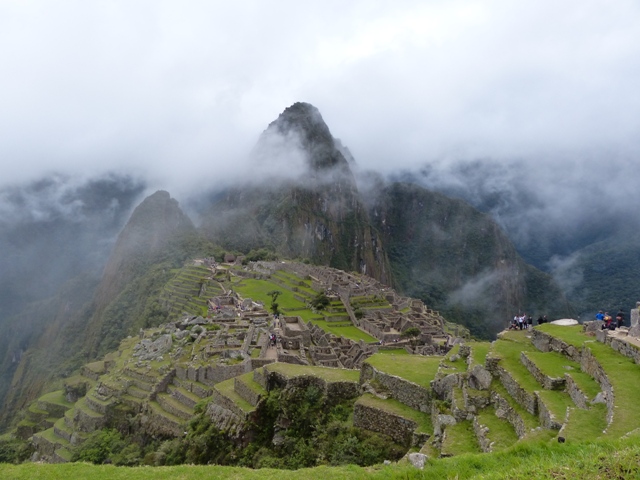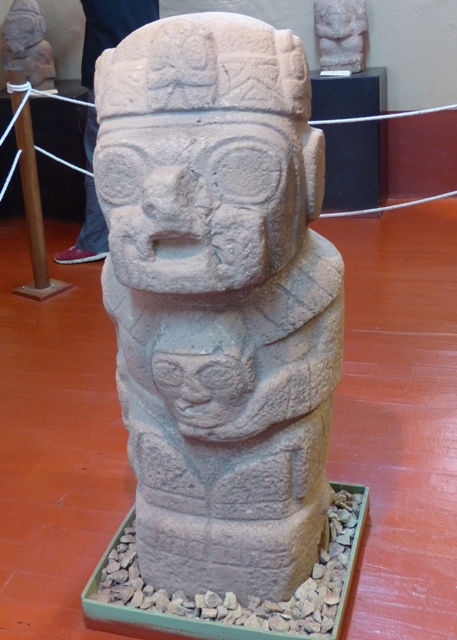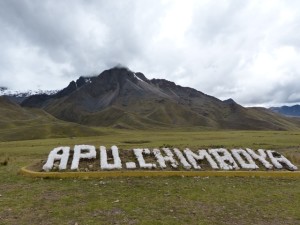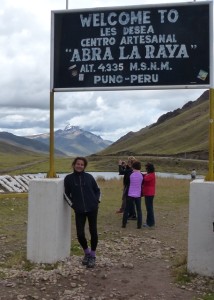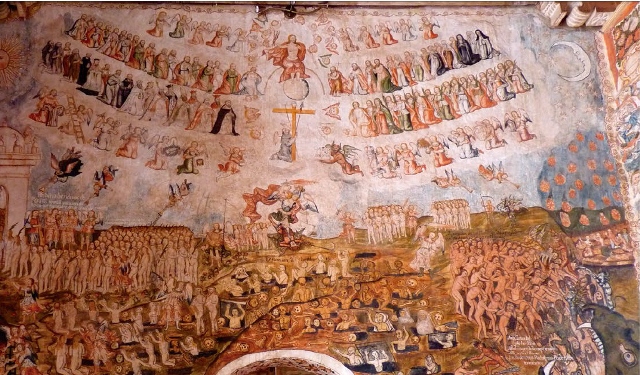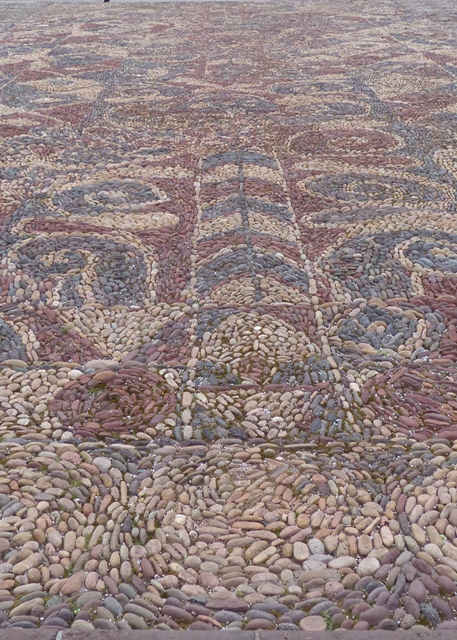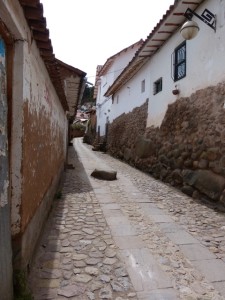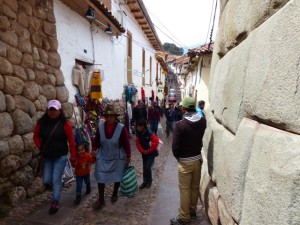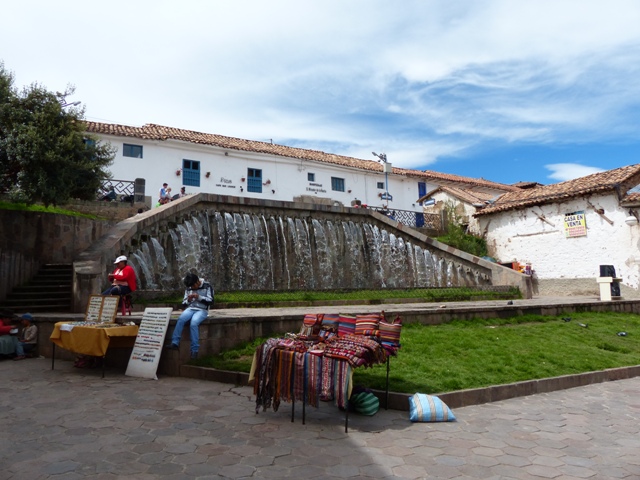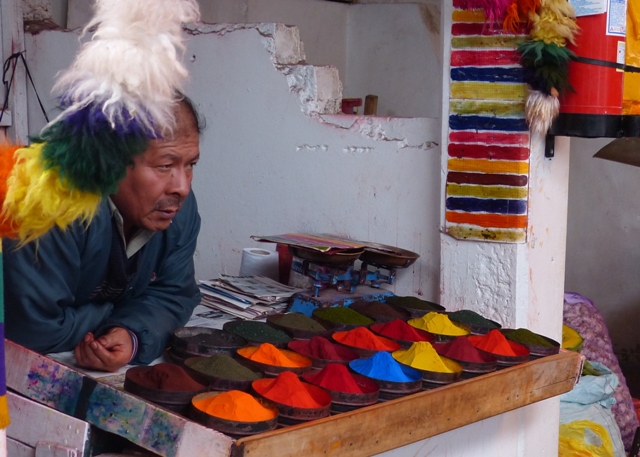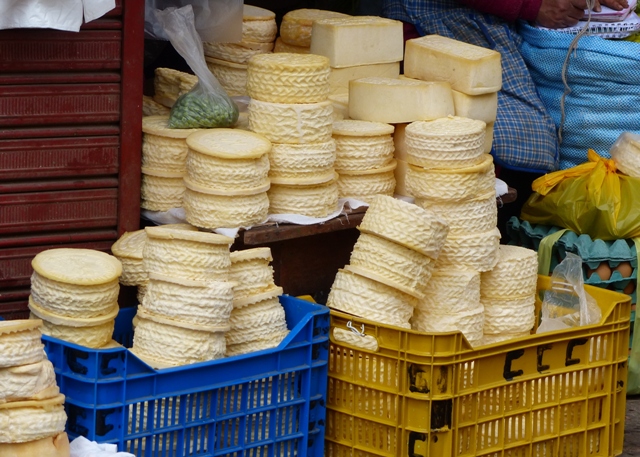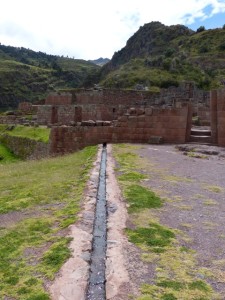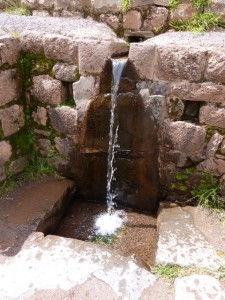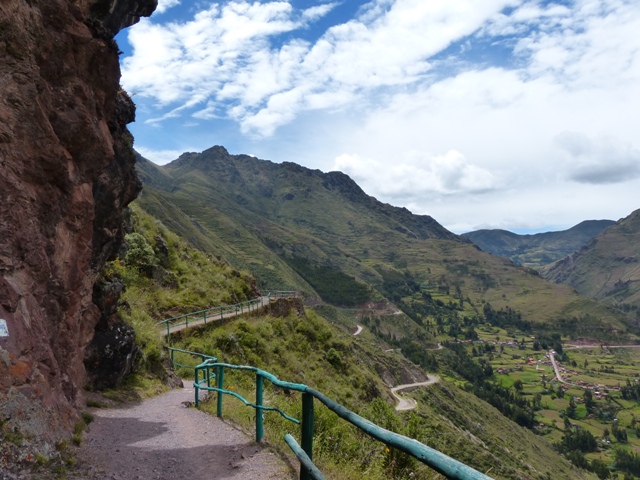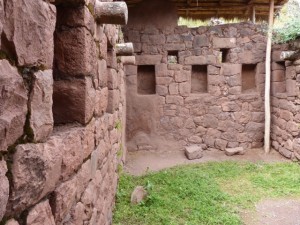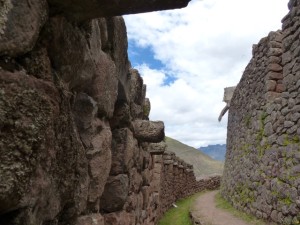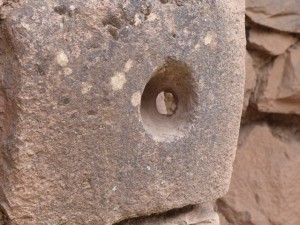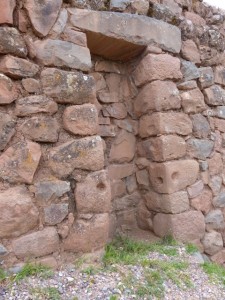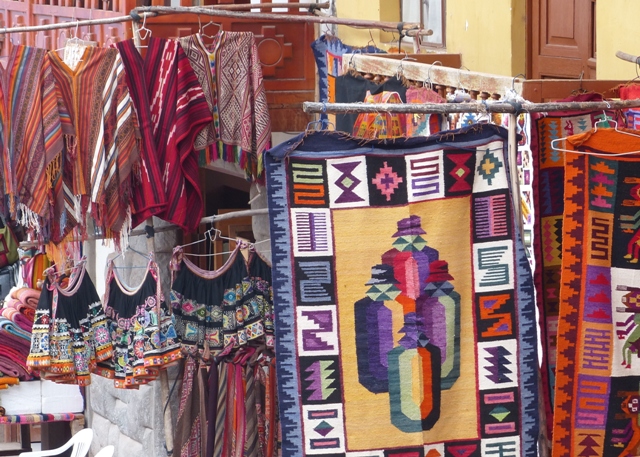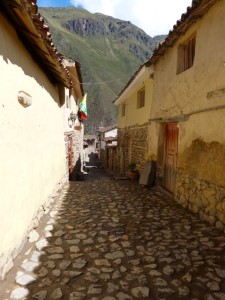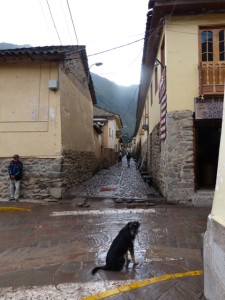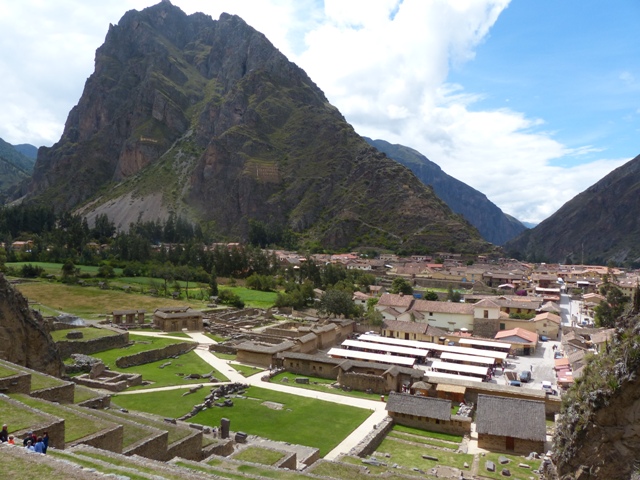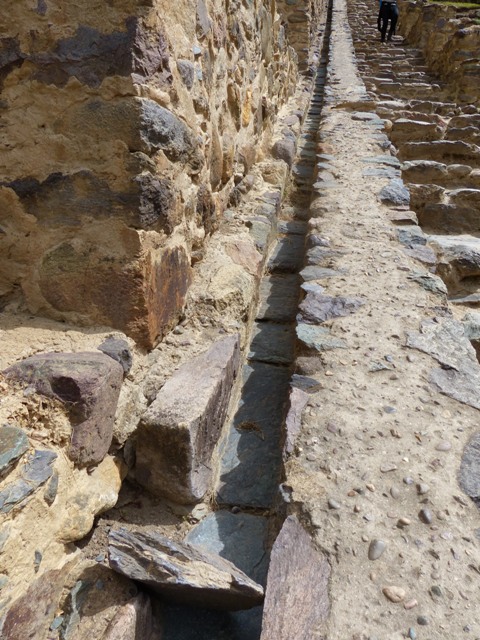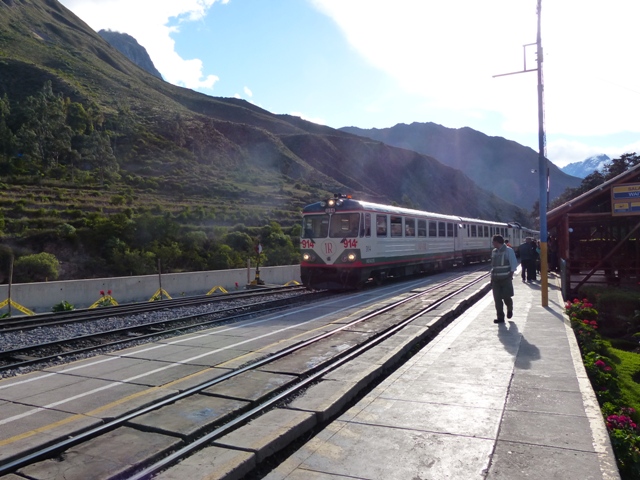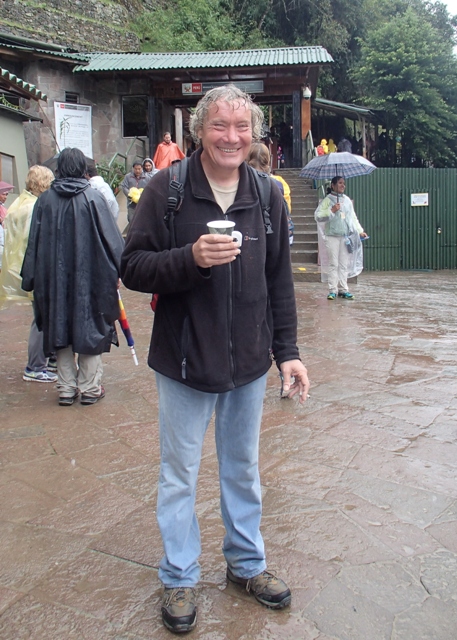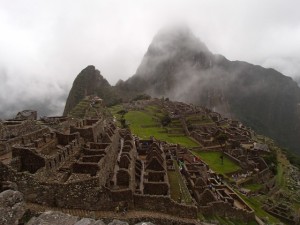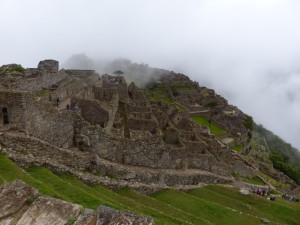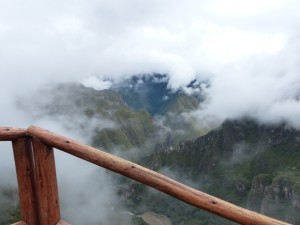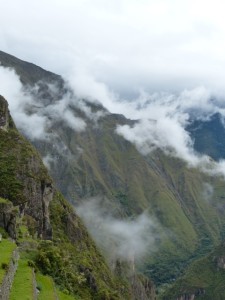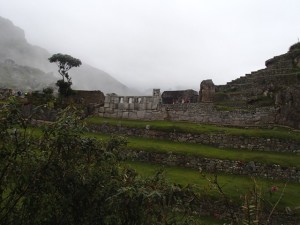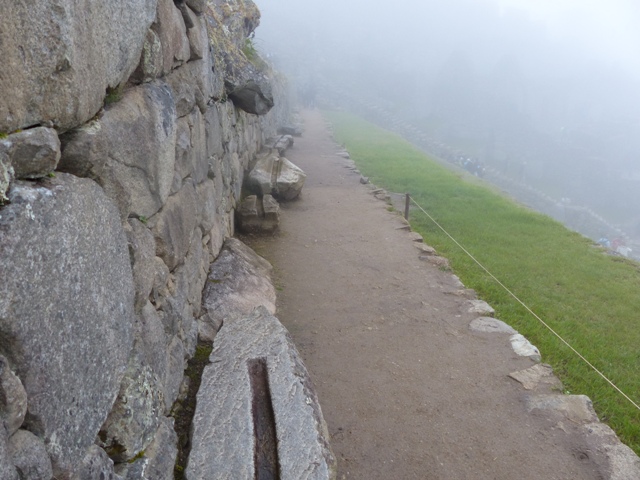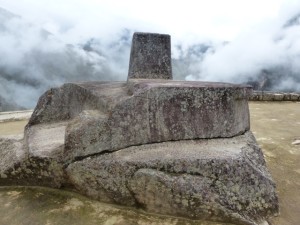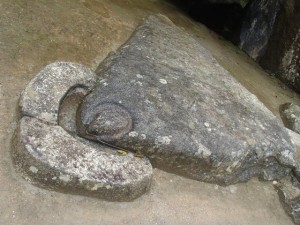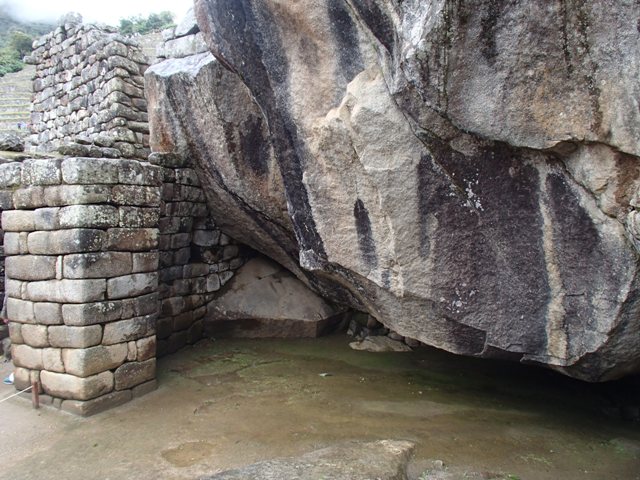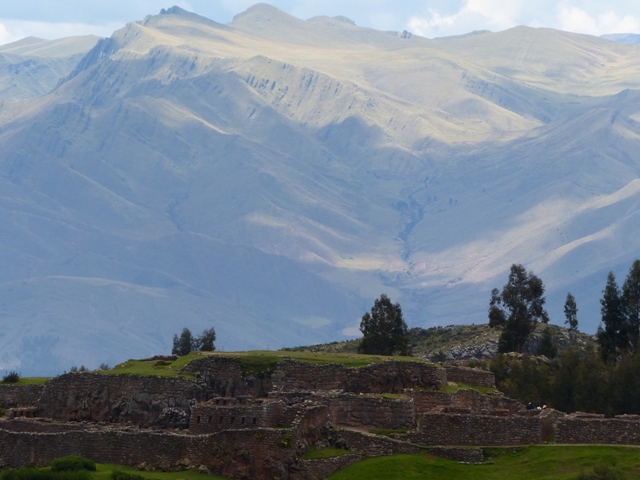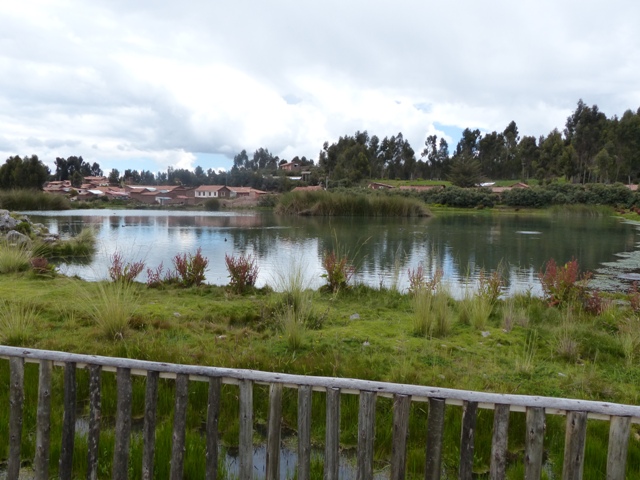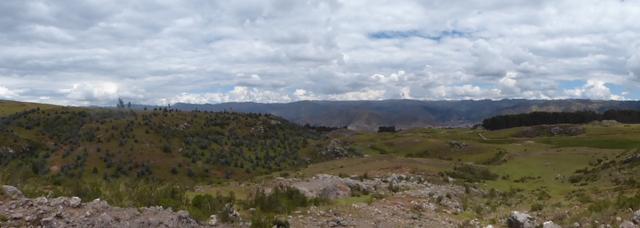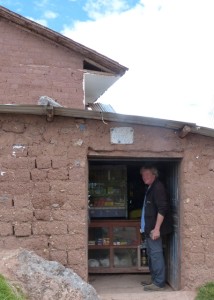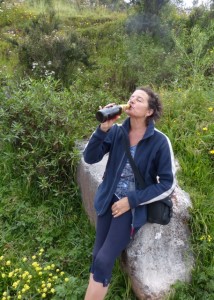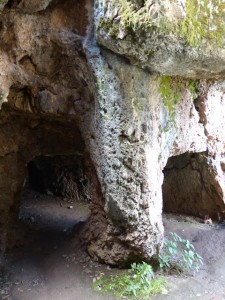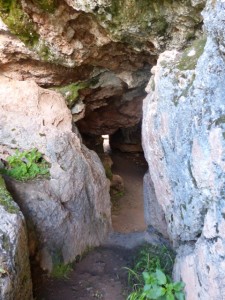Here I am again – back in Peru for this post. I am still hoping I can eventually catch up with myself!
From Lake Titicaca we wanted to travel to Cusco [often spelt Cuzco] and had been told by some cruisers we met in Shelter Bay that Peru Rail ran an excellent trip on the “Andean Explorer”. It sounded very good but, having looked into it and found that it cost US$164 [approx £115] per person, I looked for alternatives. There are, obviously, “normal” buses which ply the route but I also came across “Inca Express” which I recommend highly. I have seen comments on the Lonely Planet website about this trip being a “rip-off” [so I am not sure what those people thought about the Peru Rail cost] but we felt that the Inca Express was excellent value for money. Basically, for $50 [£35] per person we followed the route of the train but stopped at six different places – one of which was a restaurant for a buffet lunch included in the price. We did have to pay entrance fees for a couple of the sites but these were minimal.
Our first stop was Pukará where, once again, we saw statues of bulls perched on roofs for good luck – this one on the church gates.
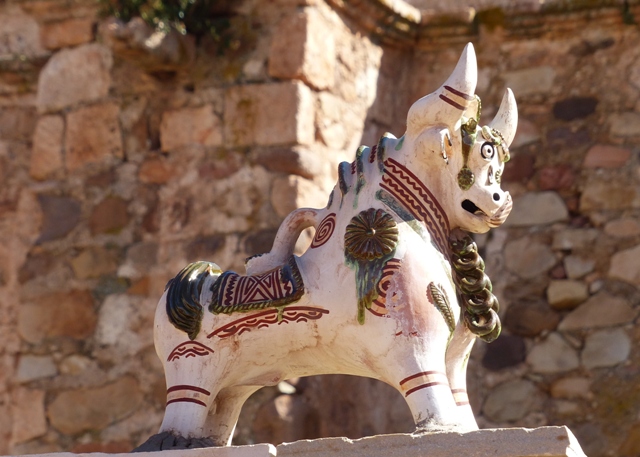 Pukará is an Andean village near to the site of Kalasaya which was first inhabited between 500BC and 200AD and, in its heyday, was over a square kilometre in size and housed thousands of people – mainly priests, farmers and herders but also some warriors.
Pukará is an Andean village near to the site of Kalasaya which was first inhabited between 500BC and 200AD and, in its heyday, was over a square kilometre in size and housed thousands of people – mainly priests, farmers and herders but also some warriors.
We didn’t visit the actual site but spent time in the museum which showcases some impressive sculptures the most famous being “Guerrero Pukará”…
From Pukará the coach climbed to 4,335metres [approx 13,440ft] above sea level where, at Apu Chimboya…
…..we visited the roadside craft area of “Abra La Raya”.
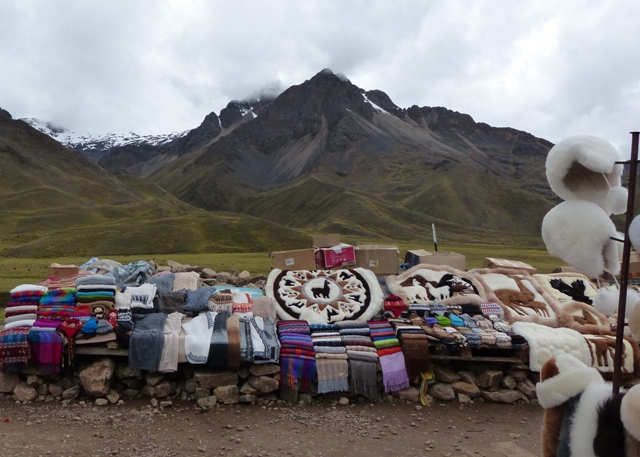 Lower down the valley at 3,550metres [11,000ft] our next stop was Raqchi with its small church [and posing tourist – though I don’t understand what he is posing as!]….
Lower down the valley at 3,550metres [11,000ft] our next stop was Raqchi with its small church [and posing tourist – though I don’t understand what he is posing as!]….
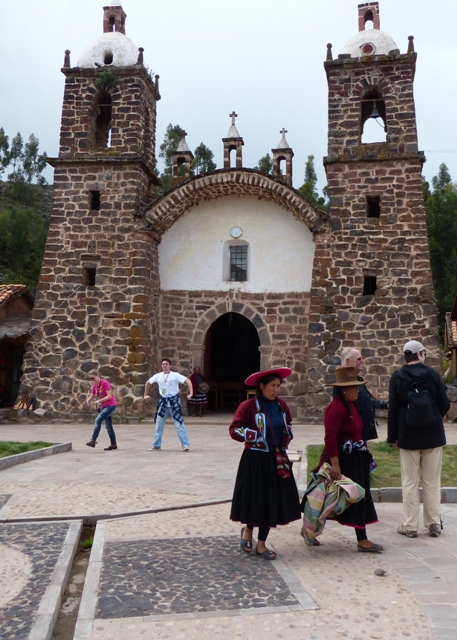 Raqchi is the site of the Wiracocha Temple ruins dedicated to the worship of the ”Creator of the Universe – Apu Con Tiki Wiracocha” who was the “Incan Invisible God of the Andean People”.
Raqchi is the site of the Wiracocha Temple ruins dedicated to the worship of the ”Creator of the Universe – Apu Con Tiki Wiracocha” who was the “Incan Invisible God of the Andean People”.
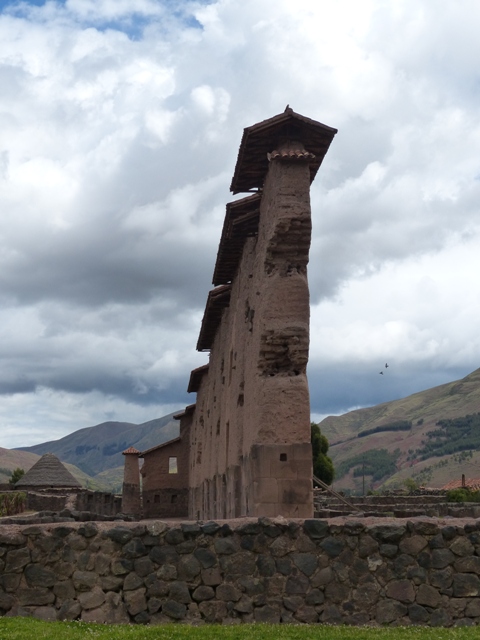 To support the roof of the temple, which inclined at around 50 degrees, there were eleven circular columns on each side of the central wall…..
To support the roof of the temple, which inclined at around 50 degrees, there were eleven circular columns on each side of the central wall…..
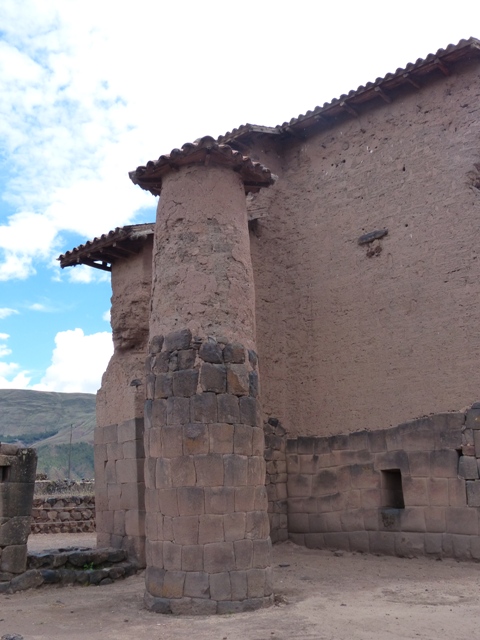 ….and the walls of the temple and the buildings which housed Raqchi’s inhabitants were, like most Incan constructions, also inclined to give a stronger base.
….and the walls of the temple and the buildings which housed Raqchi’s inhabitants were, like most Incan constructions, also inclined to give a stronger base.
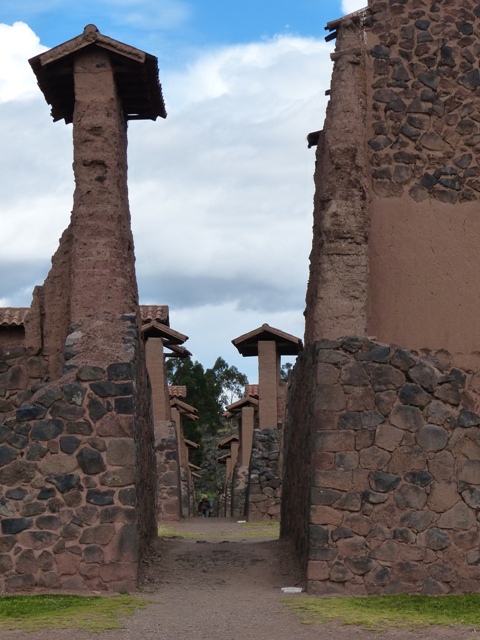 As well as vines and vegetables, grain was grown and harvested before being stored in more than 50 granaries – which gives you some idea of the size of the site and number of people who lived there.
As well as vines and vegetables, grain was grown and harvested before being stored in more than 50 granaries – which gives you some idea of the size of the site and number of people who lived there.
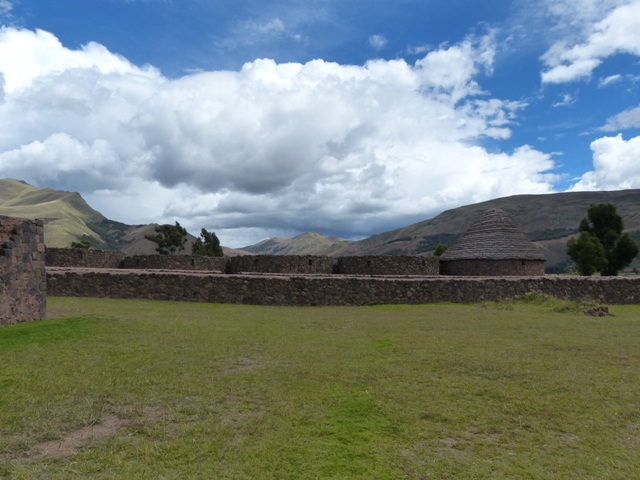 An Inca Trail runs through the site….
An Inca Trail runs through the site….
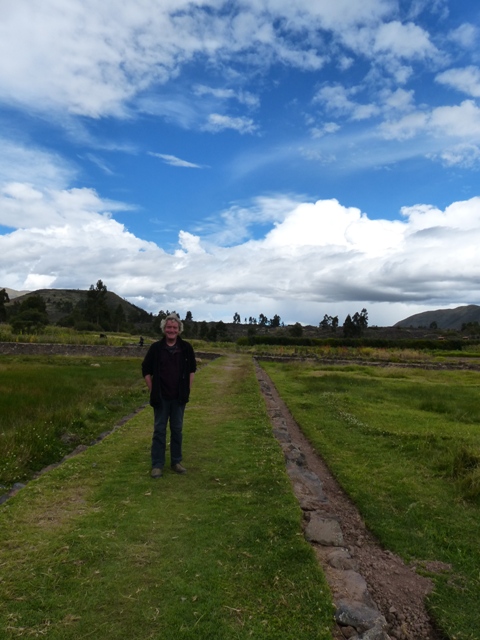 ….so, although we didn’t walk the famous one up to Machu Picchu, we can truthfully say that we have been on the Inca Trail!
….so, although we didn’t walk the famous one up to Machu Picchu, we can truthfully say that we have been on the Inca Trail!
Our final two stops were churches – part of the Route of the Andean Baroque – promoted by the “Society of Jesus”. The income obtained from this Route is used for social work in the parishes [lunch rooms, libraries and play centres, health campaigns and services, residence halls to enable children to attend school etc] and also for restoration. Although photographs were allowed outside, no shots were allowed inside either church. However, we were given a DVD which contained details about the work of the Jesuits and about the churches and included lots of photographs of the interiors and the paintings – some of which I have used below.
Firstly we visited Huaro…..
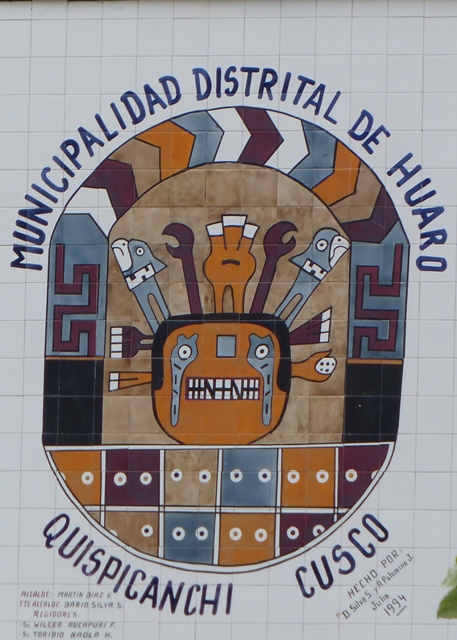 ….and the temple of San Juan Bautista [St John the Baptist]
….and the temple of San Juan Bautista [St John the Baptist]
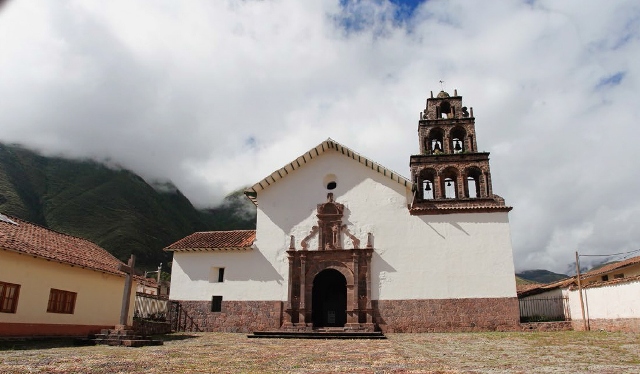 All of the walls were covered in murals….
All of the walls were covered in murals….
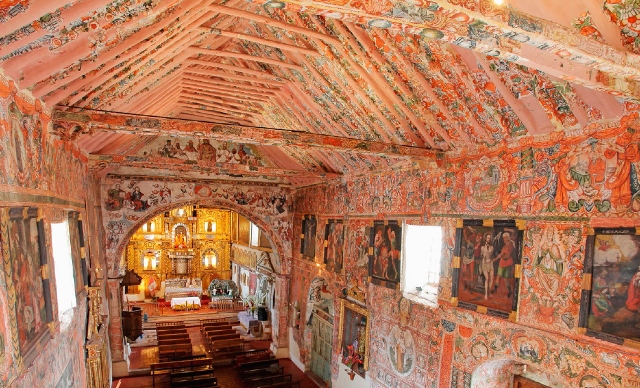 ….some of them faded or worn away and we were told that the restorers are not allowed to “reconstruct” the painting – only preserve what remains.
….some of them faded or worn away and we were told that the restorers are not allowed to “reconstruct” the painting – only preserve what remains.
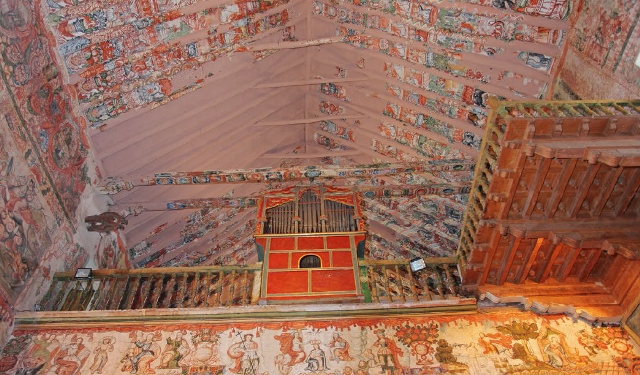 Just inside the door of the church were two particularly striking murals – “Final Judgement Day”……
Just inside the door of the church were two particularly striking murals – “Final Judgement Day”……
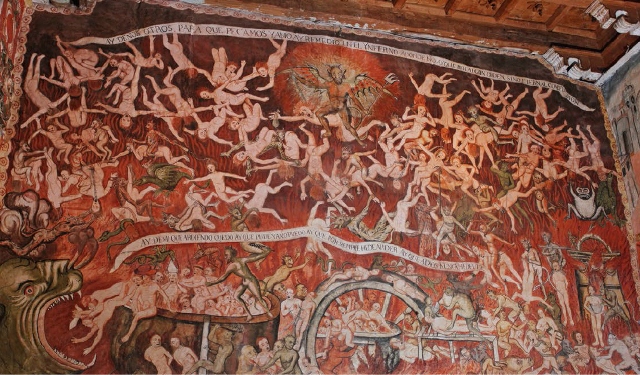 Clearly these portrayed pictorially messages which the church wanted to give to a people who spoke a different language. They would have been left in no doubt about what happened to transgressors!
Clearly these portrayed pictorially messages which the church wanted to give to a people who spoke a different language. They would have been left in no doubt about what happened to transgressors!
Our second church was in Andahuaylillas – a very quaint town with a beautiful square surrounded on three sides by balconied houses and containing the brightly flowering Pisonay trees…..
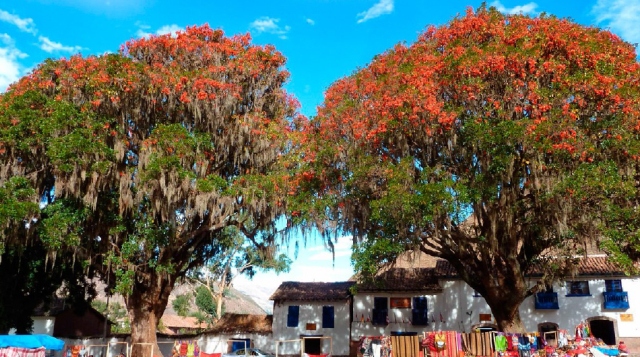 On its fourth side is what is known as “La Capilla Sixtina de América” [The Sistine Chapel of America – actually the Ingelesia de San Pedro (Church of St. Peter)] fronted [as was Huaro church] by a pebbled mosaic area….
On its fourth side is what is known as “La Capilla Sixtina de América” [The Sistine Chapel of America – actually the Ingelesia de San Pedro (Church of St. Peter)] fronted [as was Huaro church] by a pebbled mosaic area….
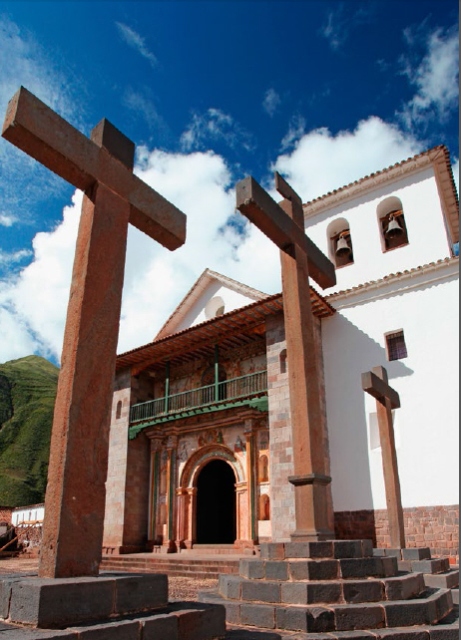 The inside of this church was far more “showy” with lots of gilt…..
The inside of this church was far more “showy” with lots of gilt…..
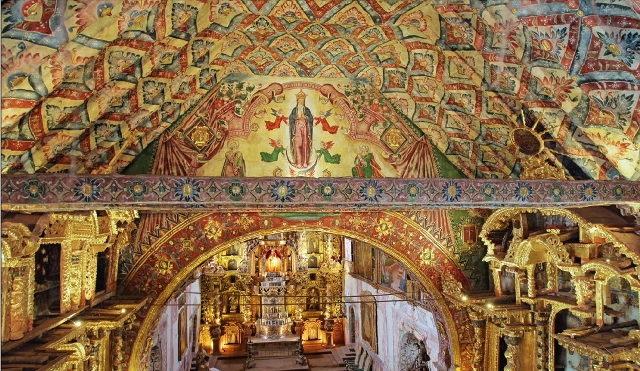 …and several altars all with statues dressed in a variety of clothes….
…and several altars all with statues dressed in a variety of clothes….
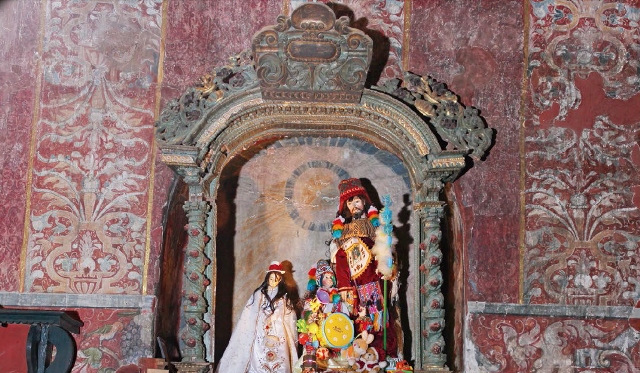 I really love the Michael Jackson effect!
I really love the Michael Jackson effect!
On the road again we passed the huge Inca gate – “Rumicolca”……
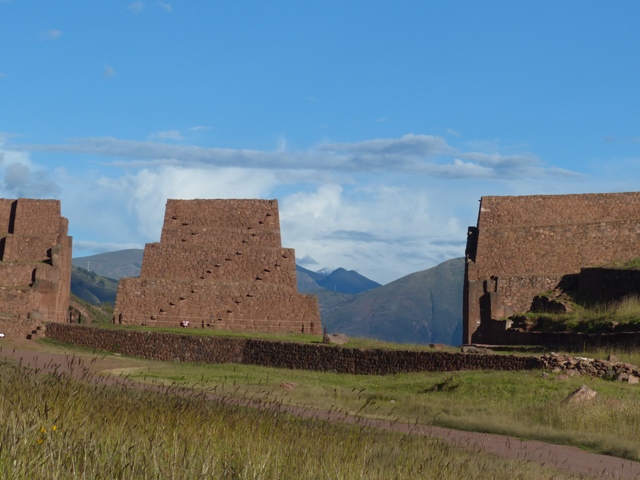 ….built on Wari foundations, and the final 35k of the journey gave us some more stunning views of the valley with its lakes and mountains.
….built on Wari foundations, and the final 35k of the journey gave us some more stunning views of the valley with its lakes and mountains.
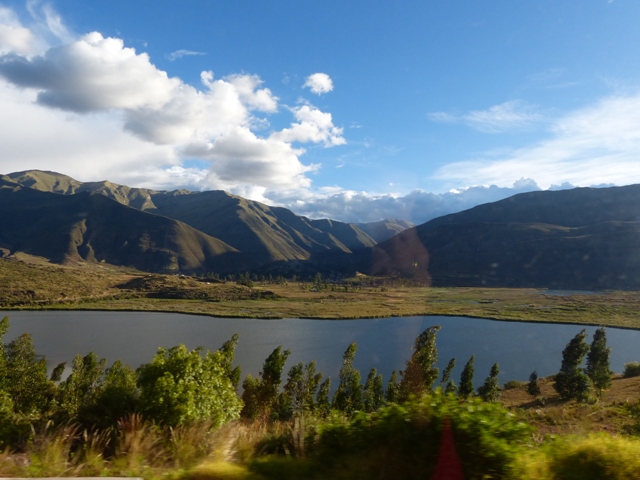 All in all, we think it was an excellent way to travel between Puno and Cusco though, having set off at 7am, we were beginning to sag a little by our arrival time of 5pm.
All in all, we think it was an excellent way to travel between Puno and Cusco though, having set off at 7am, we were beginning to sag a little by our arrival time of 5pm.
The foremost city of the Inca Empire, Cusco is the Americas oldest continuously inhabited city. The history of the city is reflected everywhere – for example “Loreto” [a small walkway with Inca walls on both sides]…..
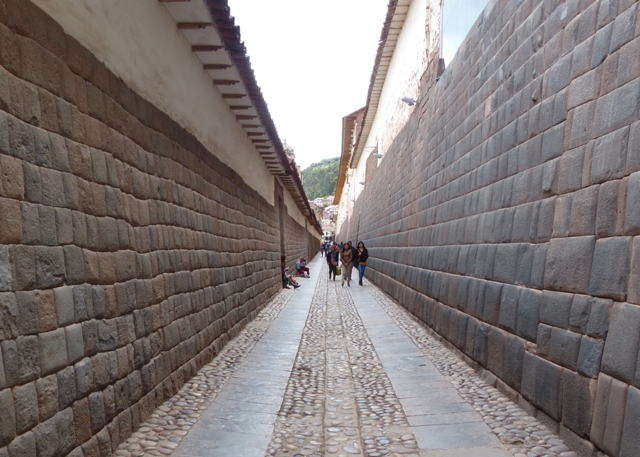 …..the East wall apparently being one of the “best” examples of Inca stonework.
…..the East wall apparently being one of the “best” examples of Inca stonework.
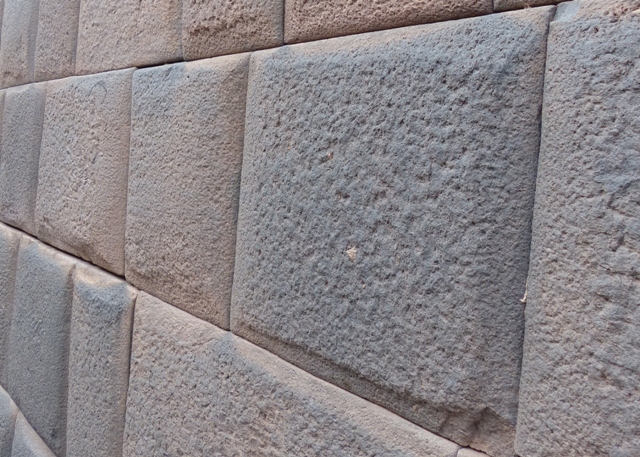 Nestled onto a steep hillside at the north west side of the city is the San Blas district with its many narrow lanes and passageways [mainly traffic free] ……..
Nestled onto a steep hillside at the north west side of the city is the San Blas district with its many narrow lanes and passageways [mainly traffic free] ……..
There is classic architecture everywhere and “signature” blue doors predominate.
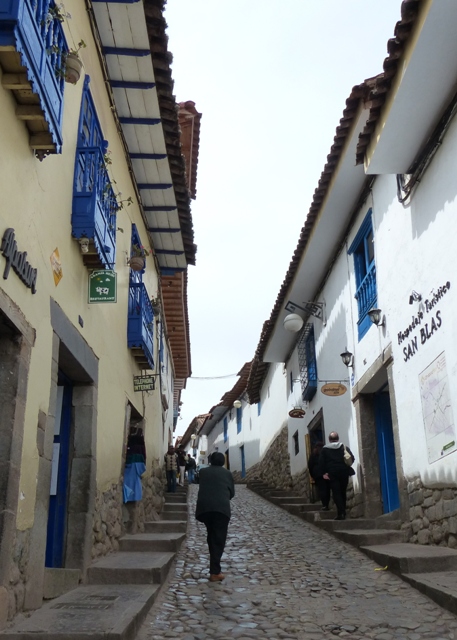 The Plaza de Armas is surrounded by colonial arcades….
The Plaza de Armas is surrounded by colonial arcades….
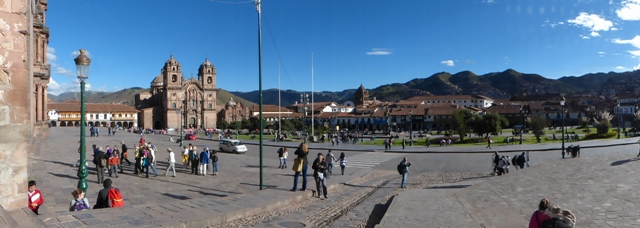 …. with the Inglesia de la Compañia de Jesús on its southern edge dominating this photograph.
…. with the Inglesia de la Compañia de Jesús on its southern edge dominating this photograph.
In reality, La Cathedral, flanked by two other churches and “squatting” on the site of an Inca Palace, is the real landmark of the plaza.
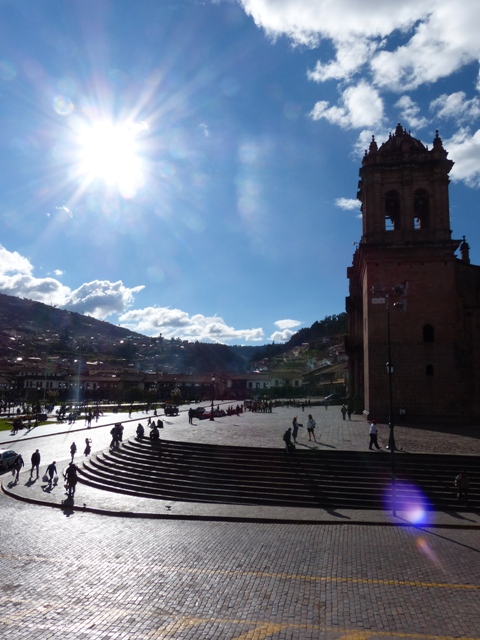 I particularly like the statuary along its rooftops.
I particularly like the statuary along its rooftops.
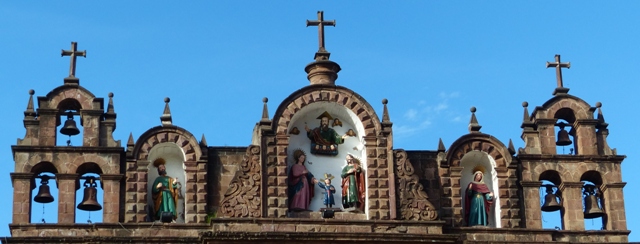 We bought a combined “Boleto Turístico del Cusco” [approx £25[$33]pp giving access to 16 sites and lasting 10 days] which, as well as allowing us entrance to some of the archaeological sites I will tell you about later, also enabled us to visit five city museums. We visited two and, unfortunately, weren’t particularly impressed – we much preferred the “Museo Inka” for which we had to pay a separate fee.
We bought a combined “Boleto Turístico del Cusco” [approx £25[$33]pp giving access to 16 sites and lasting 10 days] which, as well as allowing us entrance to some of the archaeological sites I will tell you about later, also enabled us to visit five city museums. We visited two and, unfortunately, weren’t particularly impressed – we much preferred the “Museo Inka” for which we had to pay a separate fee.
Mercado San Pedro in the heart of the city was a place we really enjoyed with its colourful stalls selling everything from dyes….
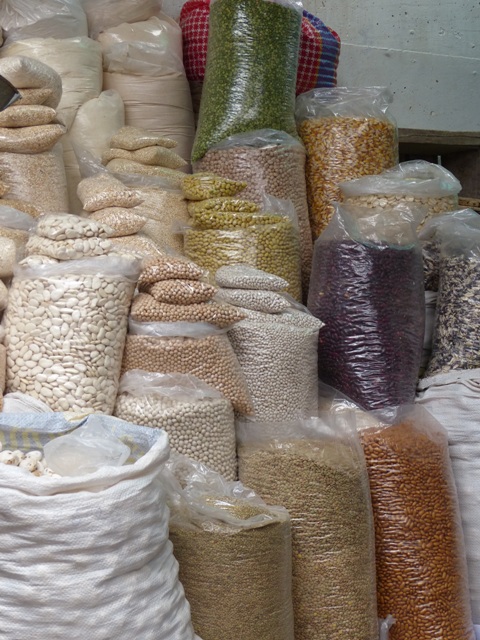 …..and spilling out in to the surrounding streets with flower sellers….
…..and spilling out in to the surrounding streets with flower sellers….
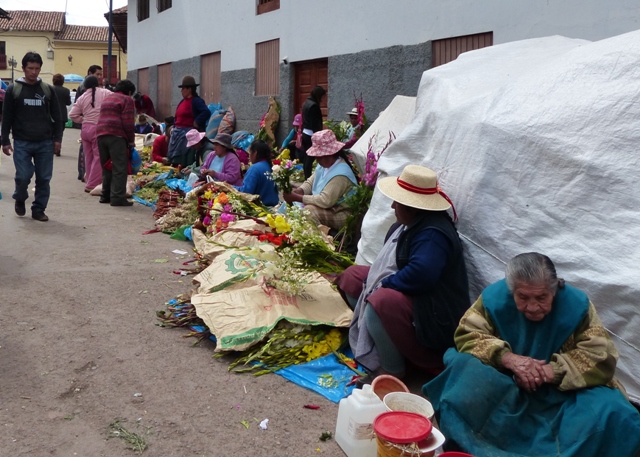 … stalls selling magnificent cheeses…..
… stalls selling magnificent cheeses…..
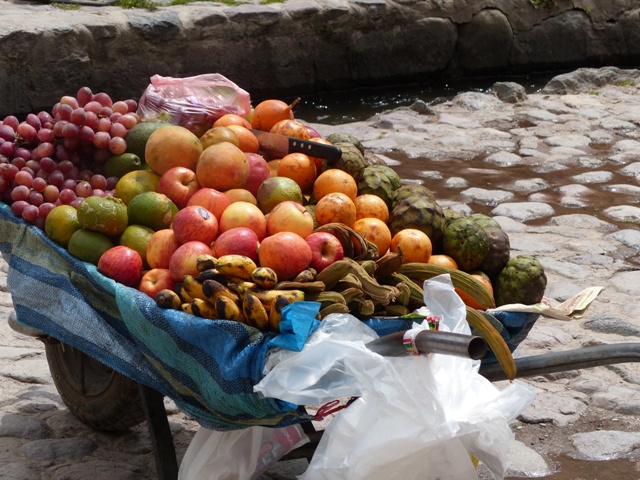 However, the “Boleta” was invaluable when it came to visiting the Inca Ruins surrounding Cusco and in the Sacred Valley. Our first trip out of the city was to Pisac which I found almost as dramatic and interesting as Machu Picchu. It maybe because it was the first large Inca site we visited but its spectacular situation perched on a mountain spur captured our imagination.
However, the “Boleta” was invaluable when it came to visiting the Inca Ruins surrounding Cusco and in the Sacred Valley. Our first trip out of the city was to Pisac which I found almost as dramatic and interesting as Machu Picchu. It maybe because it was the first large Inca site we visited but its spectacular situation perched on a mountain spur captured our imagination.
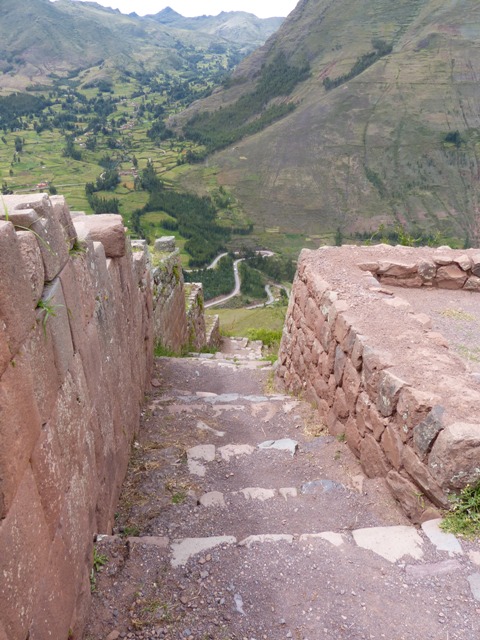 Maybe what we liked about it best was that it gets relatively few tourists and, by walking up from Pisac centre, we managed to have the place almost to ourselves for much of the time. We certainly didn’t mind coming across a local musician who played as we attained the first level.
Maybe what we liked about it best was that it gets relatively few tourists and, by walking up from Pisac centre, we managed to have the place almost to ourselves for much of the time. We certainly didn’t mind coming across a local musician who played as we attained the first level.
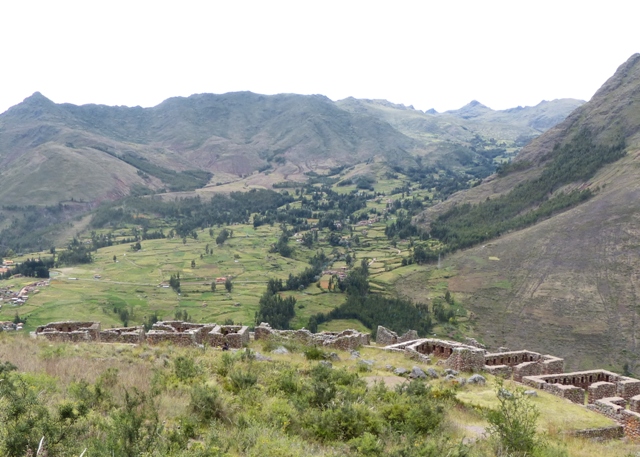 Can you see him? If not, here is a close up….
Can you see him? If not, here is a close up….
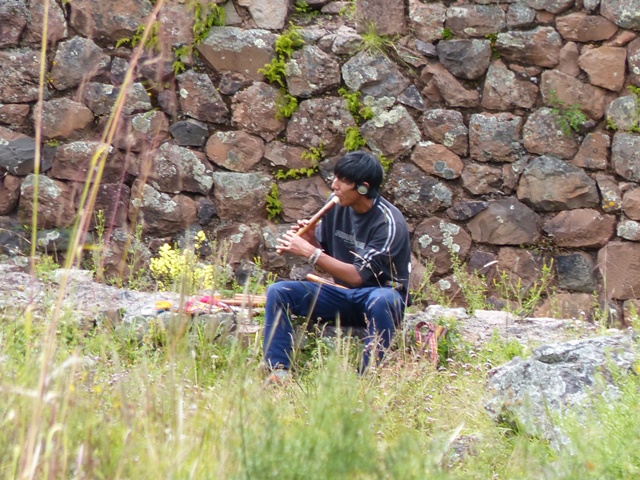 As I explained in an earlier blog post [when describing the ancient city of Tomebamba in Cuenca] water is an important feature….
As I explained in an earlier blog post [when describing the ancient city of Tomebamba in Cuenca] water is an important feature….
….though perhaps the most impressive feature of Pisac is the agricultural terracing….
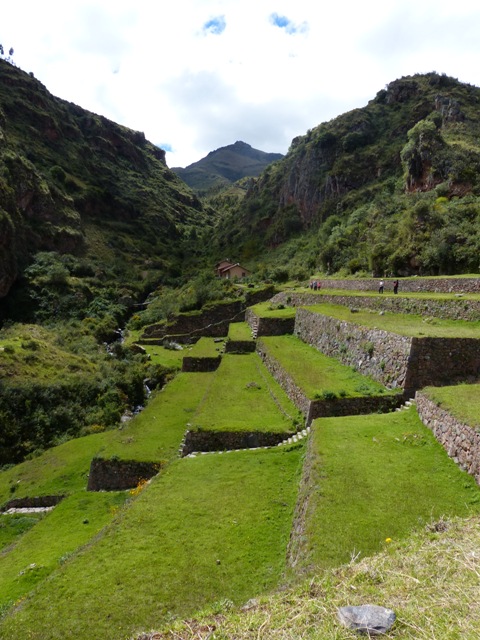 ….which sweeps around the flanks of the mountain in huge and graceful curves.
….which sweeps around the flanks of the mountain in huge and graceful curves.
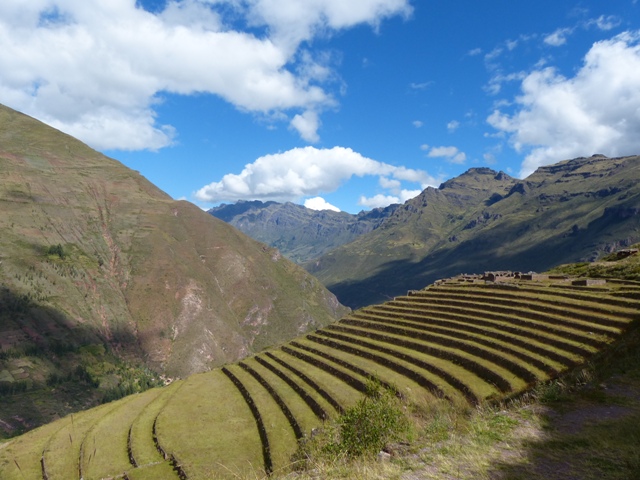 The terraces were joined by flagstones set into the terrace walls.
The terraces were joined by flagstones set into the terrace walls.
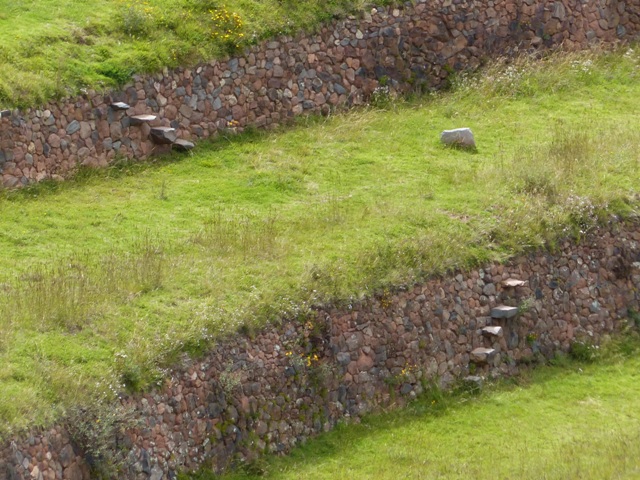 Above the terraces are cliff hugging footpaths….
Above the terraces are cliff hugging footpaths….
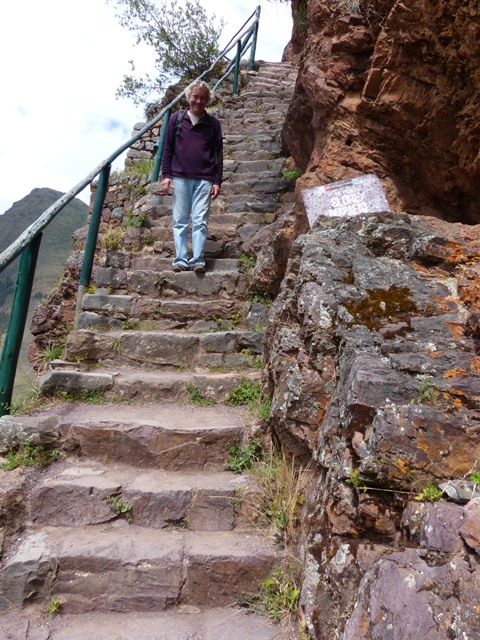 ….and a short tunnel carved out of the rock.
….and a short tunnel carved out of the rock.
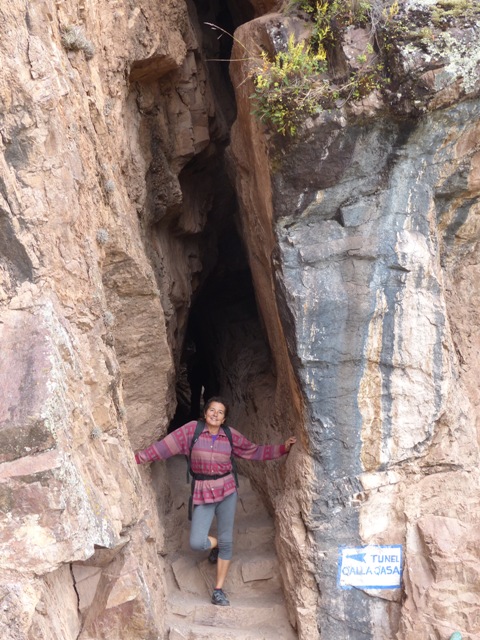 Again you can see the trapezoidal doorways …
Again you can see the trapezoidal doorways …
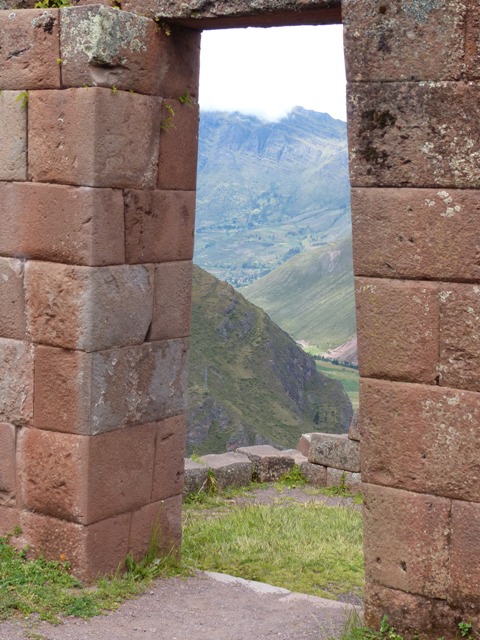 ….and here and there evidence of roof supports.
….and here and there evidence of roof supports.
Mike was quite carried away pointing everything out….
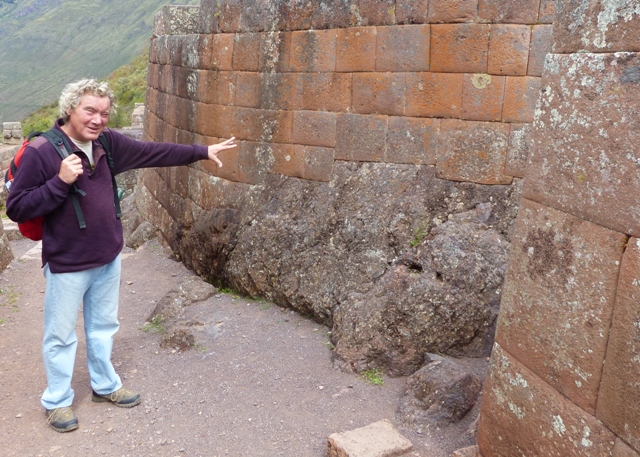 ….. though there were one or two things which puzzled us such as this small hole with water in it.
….. though there were one or two things which puzzled us such as this small hole with water in it.
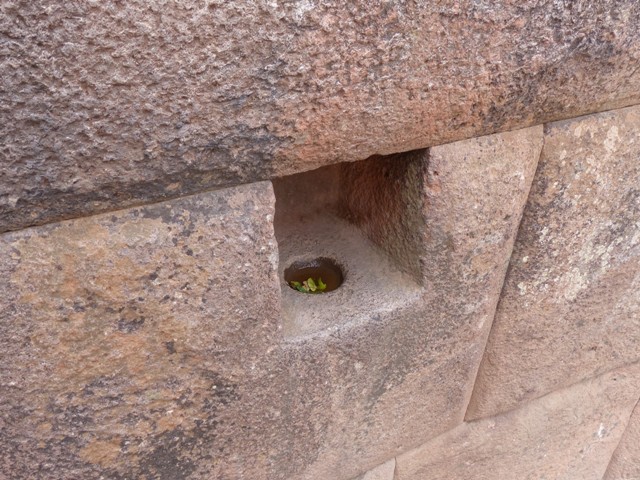 Did the water drip in there naturally or remain behind after rain? If not, who filled it up? What was it used for?
Did the water drip in there naturally or remain behind after rain? If not, who filled it up? What was it used for?
Similarly – what are these holes for? As you can see they are part of a niche – but what is their purpose?
We do know that the photograph below shows burial sites, long ago desecrated, and no longer accessible to tourists.
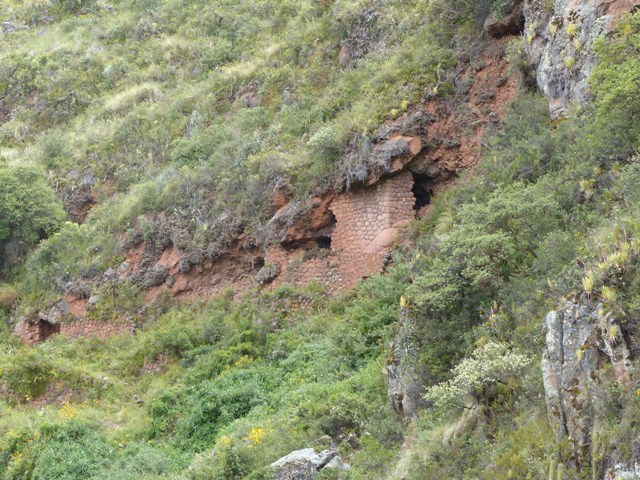 Had we known in advance we might have chosen to stay in Pisac for a night as it was a lovely colonial village with several small inns and restaurants and bustling with the usual market….
Had we known in advance we might have chosen to stay in Pisac for a night as it was a lovely colonial village with several small inns and restaurants and bustling with the usual market….
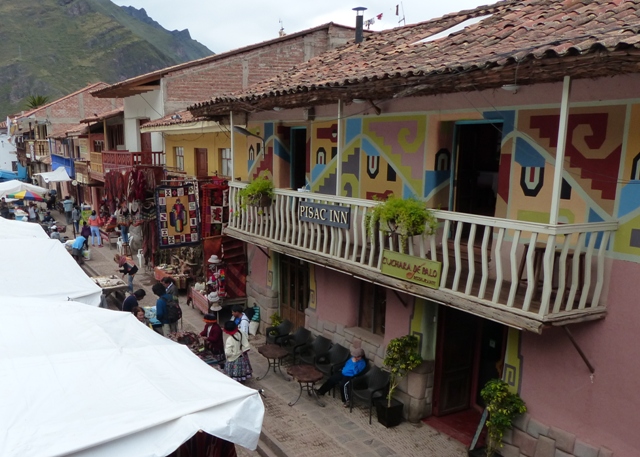 …. visited by tourists for the craft goods…
…. visited by tourists for the craft goods…
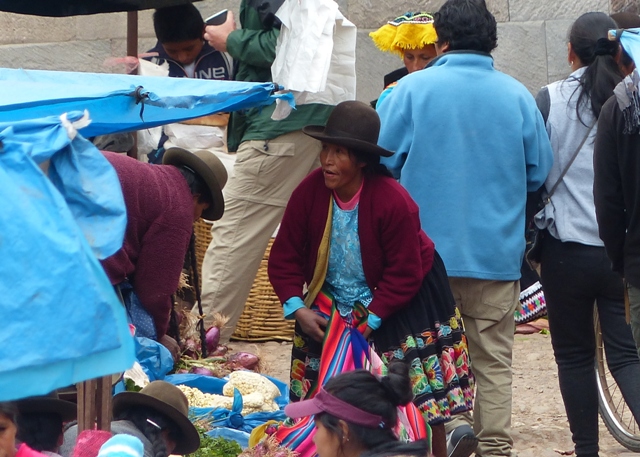 The mural just at the edge of the village where we waited for our return bus was pretty spectacular too….
The mural just at the edge of the village where we waited for our return bus was pretty spectacular too….
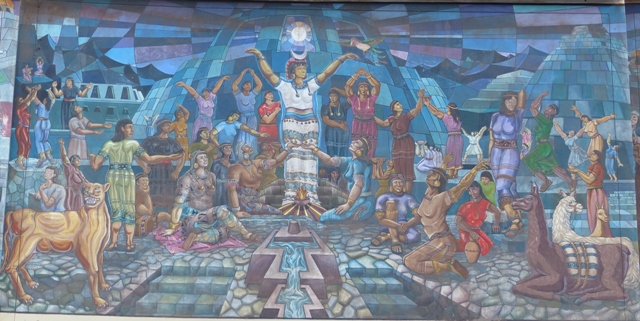 Next on the Sacred Valley hit list was Ollantaytambo – another brilliant small village – much busier than Pisac because it is where the train to Machu Picchu starts and terminates. Having said that, many tourists only visit it for a couple of hours – to see the ruins there and/or catch the train. We were really glad that we spent a night there which allowed us a good look around the very quaint streets….
Next on the Sacred Valley hit list was Ollantaytambo – another brilliant small village – much busier than Pisac because it is where the train to Machu Picchu starts and terminates. Having said that, many tourists only visit it for a couple of hours – to see the ruins there and/or catch the train. We were really glad that we spent a night there which allowed us a good look around the very quaint streets….
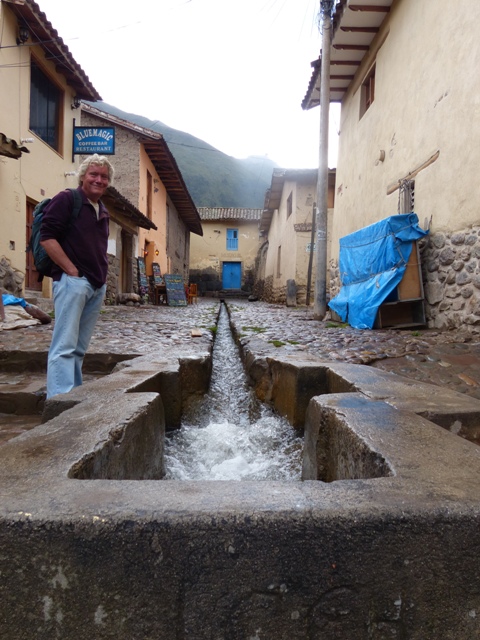 ….and to spend more time at the ruins than the organised coach tours allow.
….and to spend more time at the ruins than the organised coach tours allow.
The site is fairly large….
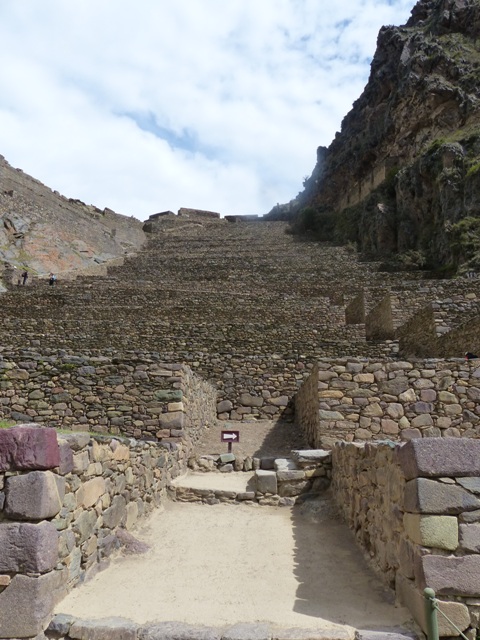 And clinging to the hillsides you can imagine how difficult these places were to access…
And clinging to the hillsides you can imagine how difficult these places were to access…
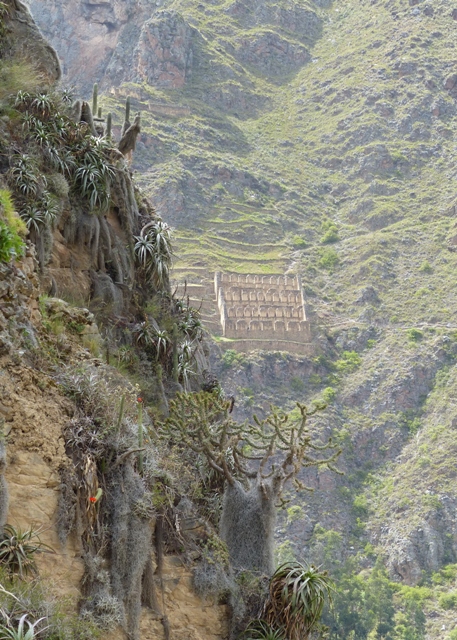 Guess that was the point if you wanted to make it difficult for your enemies! [Though, unfortunately – as you will read later – perhaps not quite difficult enough]
Guess that was the point if you wanted to make it difficult for your enemies! [Though, unfortunately – as you will read later – perhaps not quite difficult enough]
Here we could just make out some carvings in the stones….
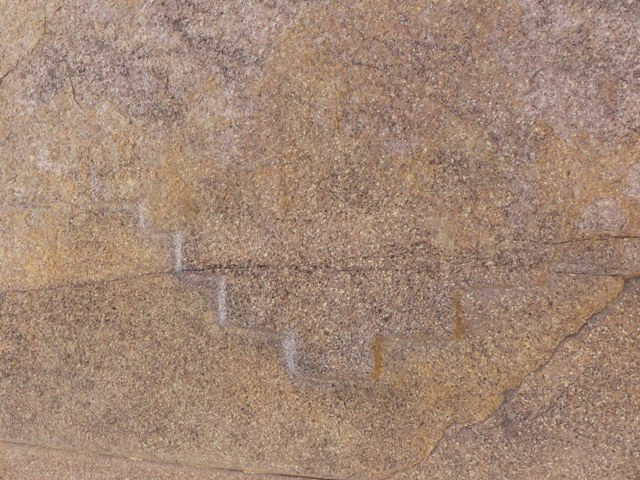 ….saw how some of the buildings were carved directly from the granite hillsides….
….saw how some of the buildings were carved directly from the granite hillsides….
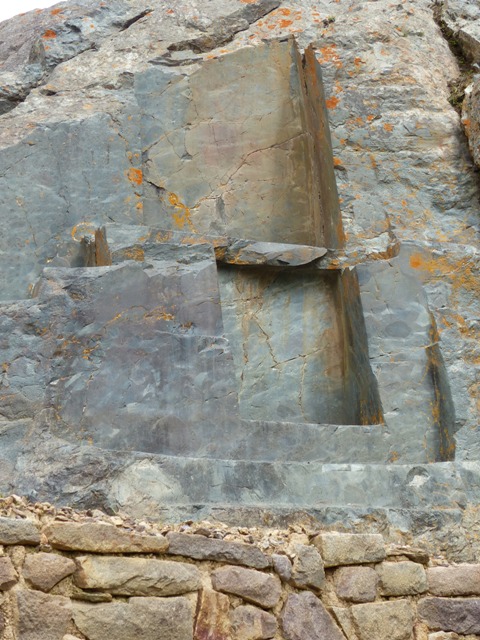 ….and how the roof supports we had seen at Pisac worked….
….and how the roof supports we had seen at Pisac worked….
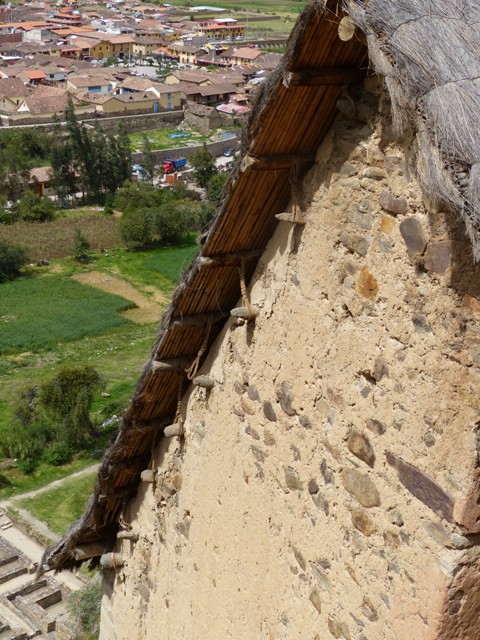 There was more evidence of the importance of water…
There was more evidence of the importance of water…
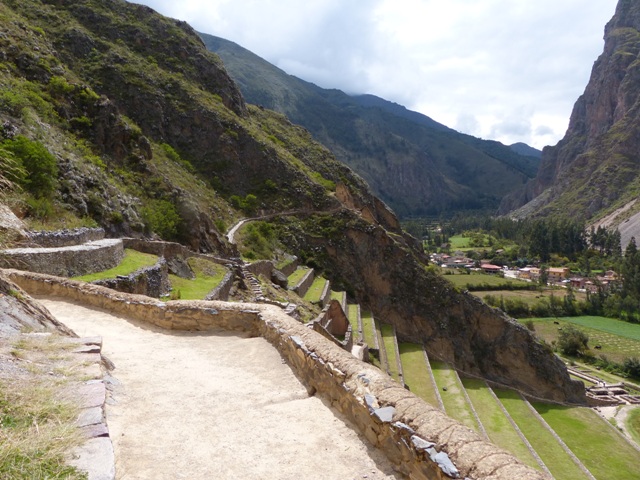 ….and how the water run offs were diverted onto those terraces…
….and how the water run offs were diverted onto those terraces…
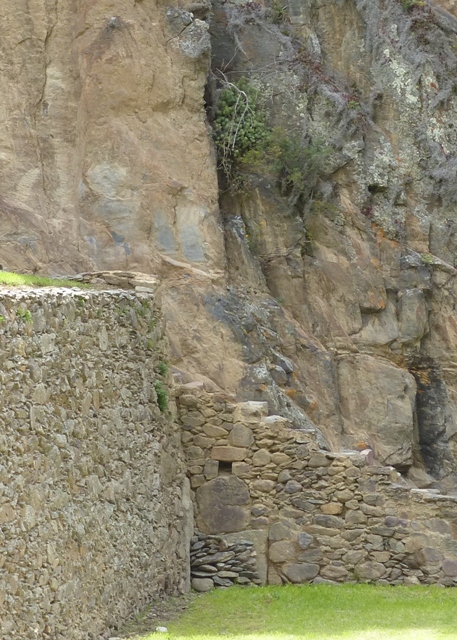 We also saw what may have been the world’s first climbing wall!!!
We also saw what may have been the world’s first climbing wall!!!
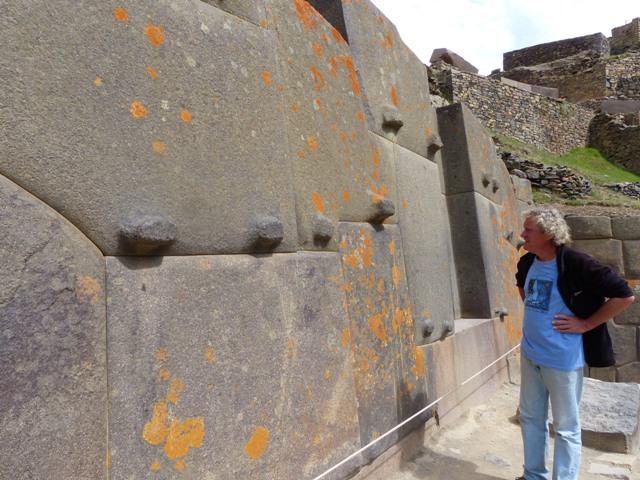 Walking down through the Ollantaytambo streets to the station was very pleasant…
Walking down through the Ollantaytambo streets to the station was very pleasant…
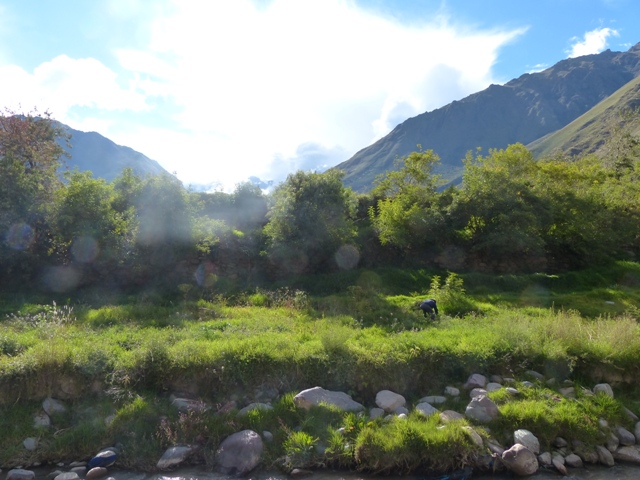 ….and it wasn’t long before our 4.30pm train to Machu Picchu arrived….
….and it wasn’t long before our 4.30pm train to Machu Picchu arrived….
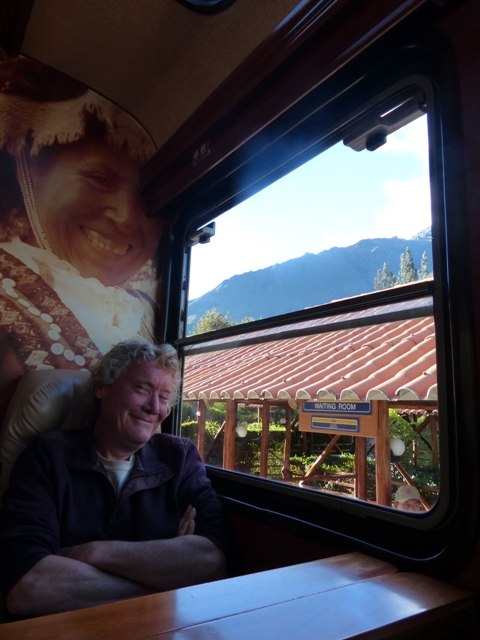 We arrived in Aguas Calientes at around 6.30pm…
We arrived in Aguas Calientes at around 6.30pm…
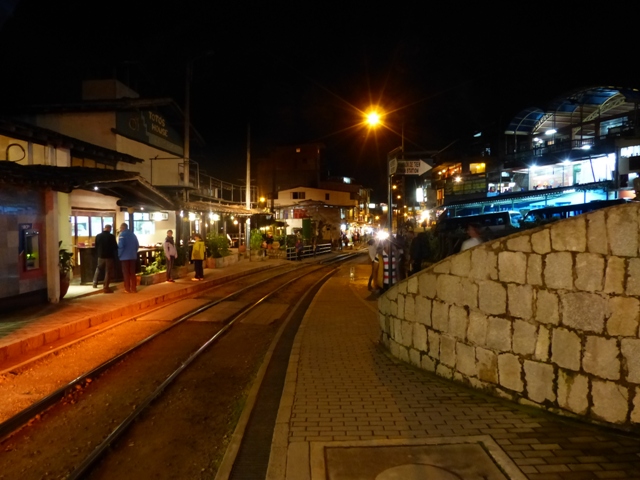 …found our accommodation and wandered around looking for a reasonable place to eat. As I said before, some people rush through Ollantaytambo to catch the train and equal numbers take an early train from Ollantaytambo and a late train back giving them just enough time to visit Machu Picchu – so they don’t really see Aguas Calientes. Although Aguas Calientes wasn’t our favourite place it wasn’t as bad as I had expected and it did allow us an early start to beat the rush.
…found our accommodation and wandered around looking for a reasonable place to eat. As I said before, some people rush through Ollantaytambo to catch the train and equal numbers take an early train from Ollantaytambo and a late train back giving them just enough time to visit Machu Picchu – so they don’t really see Aguas Calientes. Although Aguas Calientes wasn’t our favourite place it wasn’t as bad as I had expected and it did allow us an early start to beat the rush.
There were a couple of statues to remind you of where you were!
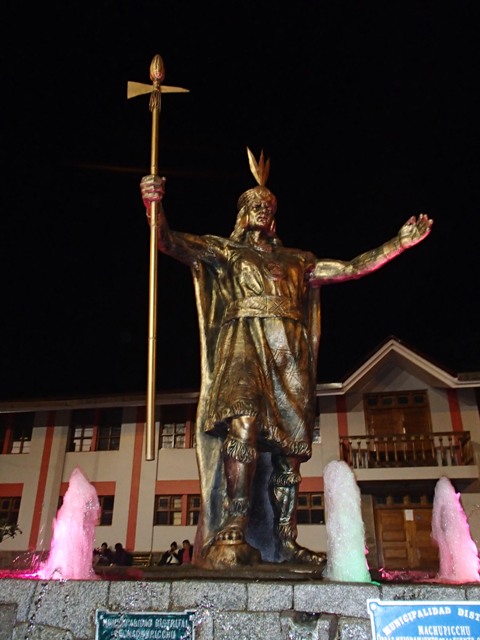 I particularly liked the one below which shows the sacred condor, puma and snake.
I particularly liked the one below which shows the sacred condor, puma and snake.
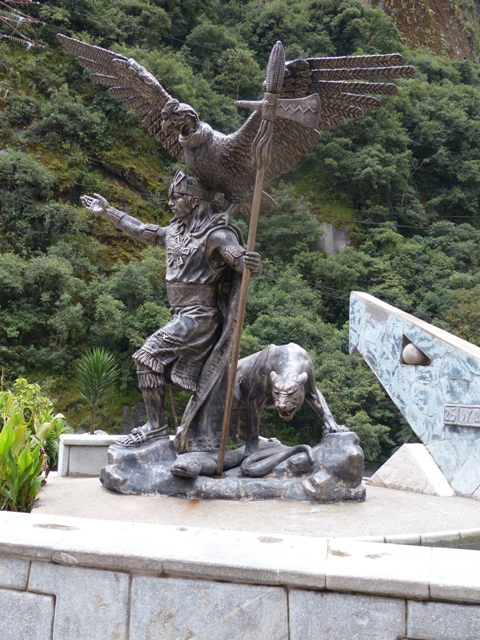 We rose early and found the town swathed in mist. This was a foretelling of things to come! The day we visited Machu Picchu was probably one of the wettest we had during the whole eight week trip!
We rose early and found the town swathed in mist. This was a foretelling of things to come! The day we visited Machu Picchu was probably one of the wettest we had during the whole eight week trip!
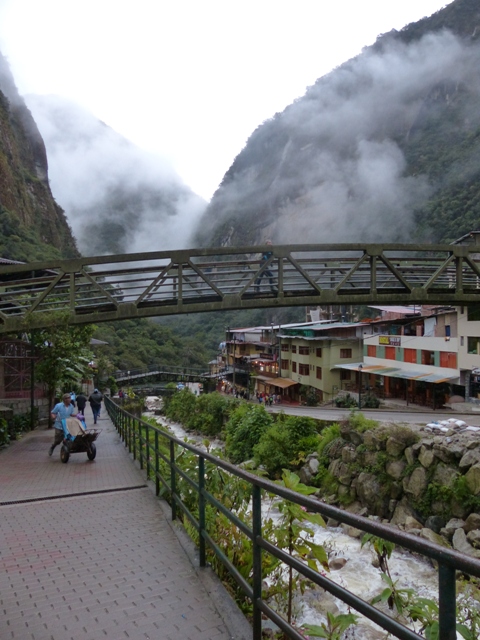 Having taken the bus up the winding 8km mountain road we entered the site wondering whether we would actually see anything…
Having taken the bus up the winding 8km mountain road we entered the site wondering whether we would actually see anything…
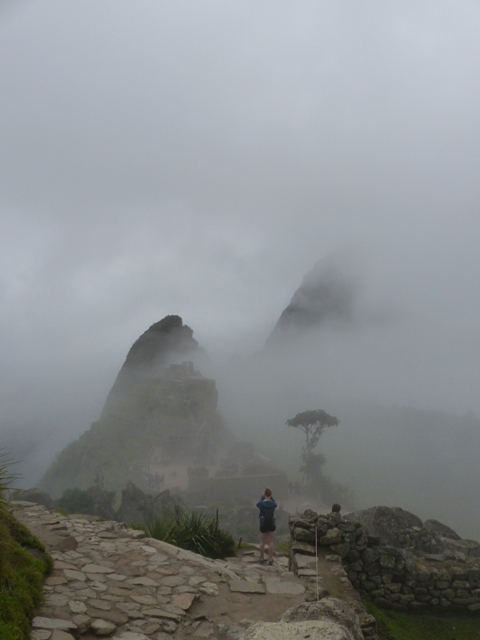 …and from there it got worse! We had to shelter for about 45 minutes in a tiny three sided hut [The Hut of the Caretaker of the Funerary Rock – the original caretaker that is, not a present day custodian!] which wind and rain still blew into – and no, there wasn’t room for everyone!
…and from there it got worse! We had to shelter for about 45 minutes in a tiny three sided hut [The Hut of the Caretaker of the Funerary Rock – the original caretaker that is, not a present day custodian!] which wind and rain still blew into – and no, there wasn’t room for everyone!
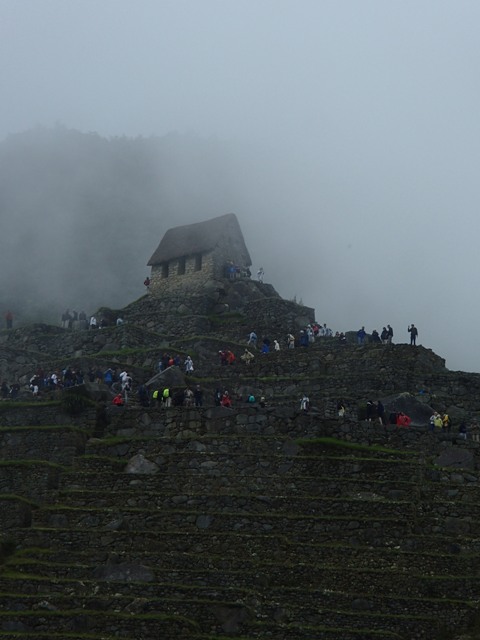 As the rain eased I suggested we return to the entrance [the only place where refreshment is available] and we had a reviving cup of coffee.
As the rain eased I suggested we return to the entrance [the only place where refreshment is available] and we had a reviving cup of coffee.
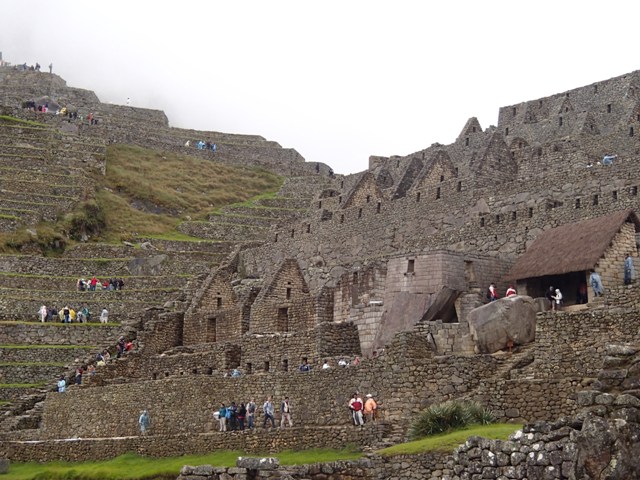 …and we began to really understand how vast the site is.
…and we began to really understand how vast the site is.
Whilst Pisac and Ollantaytambo had seemed high up and enclosed by mountains, it felt like Machu Picchu really was in the lap of the gods.
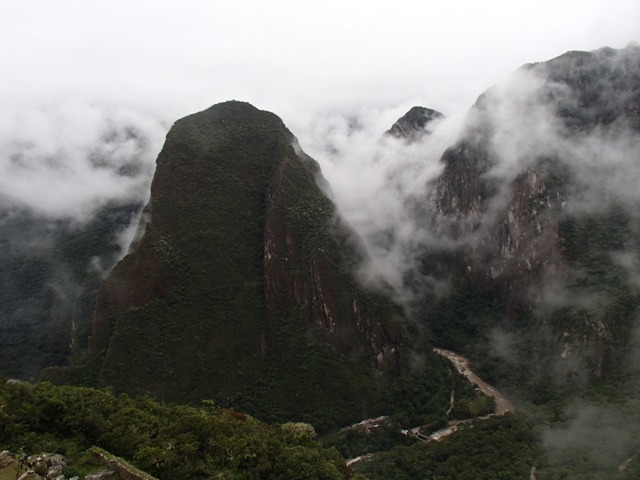 Classic architecture abounded….
Classic architecture abounded….
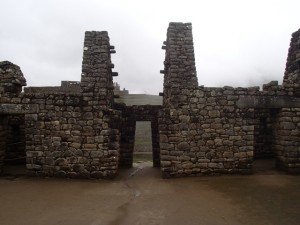
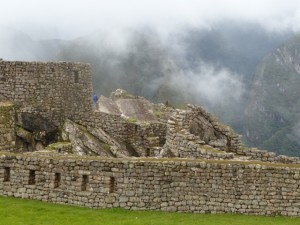
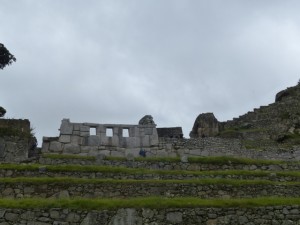 …including the temple of the three windows.
…including the temple of the three windows.
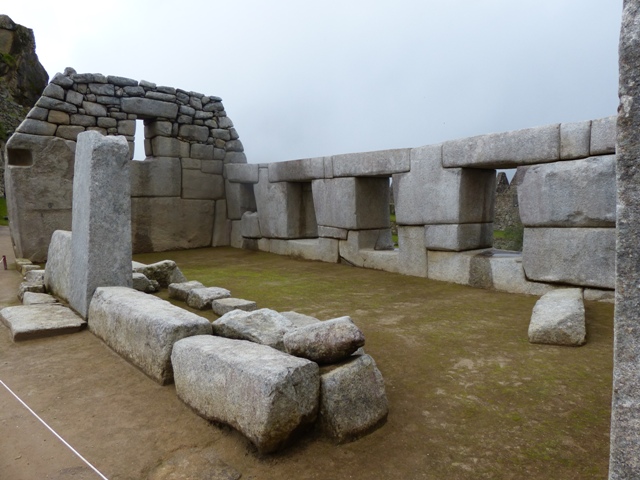 Yet again, evidence of watercourses…
Yet again, evidence of watercourses…
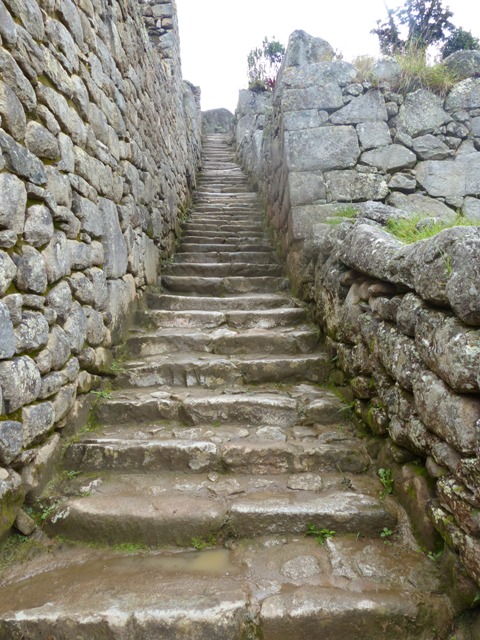 Archaeologists are still at work in the ruins…
Archaeologists are still at work in the ruins…
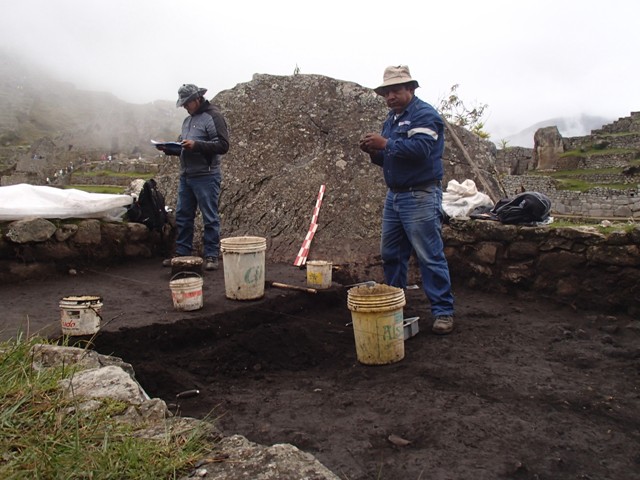 …. perhaps searching for more sacred stones of which there are many because it was once vitally important as a ceremonial centre.
…. perhaps searching for more sacred stones of which there are many because it was once vitally important as a ceremonial centre.
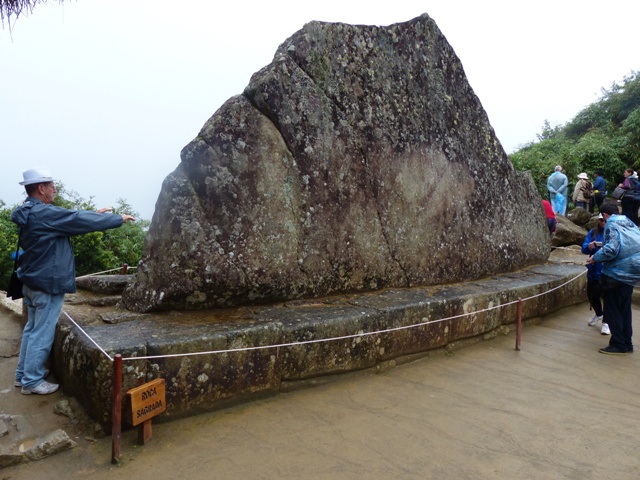 The Temple of the Sun is out of bounds, is one of very few Incan rounded buildings, but can be seen from above…
The Temple of the Sun is out of bounds, is one of very few Incan rounded buildings, but can be seen from above…
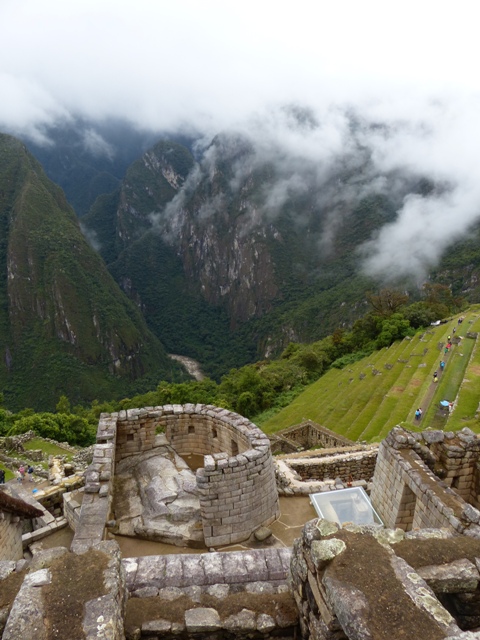 Again we marveled at how parts of the site had been built literally into the surrounding stonework…
Again we marveled at how parts of the site had been built literally into the surrounding stonework…
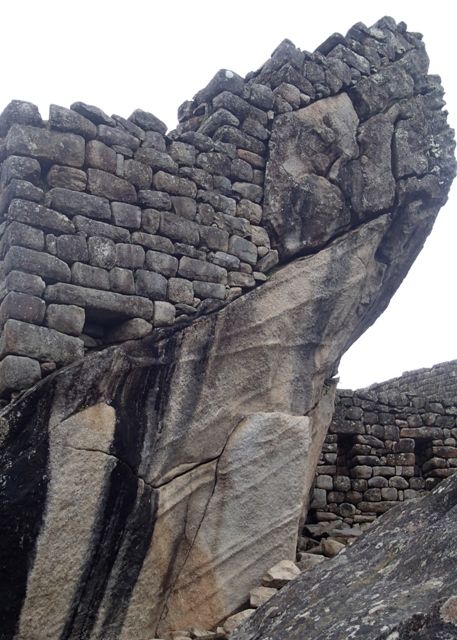 …and noted that everything we had been told about the strength of the construction based on inclining walls was probably quite correct. These walls may have slipped a little but have obviously survived some form of subsidence.
…and noted that everything we had been told about the strength of the construction based on inclining walls was probably quite correct. These walls may have slipped a little but have obviously survived some form of subsidence.
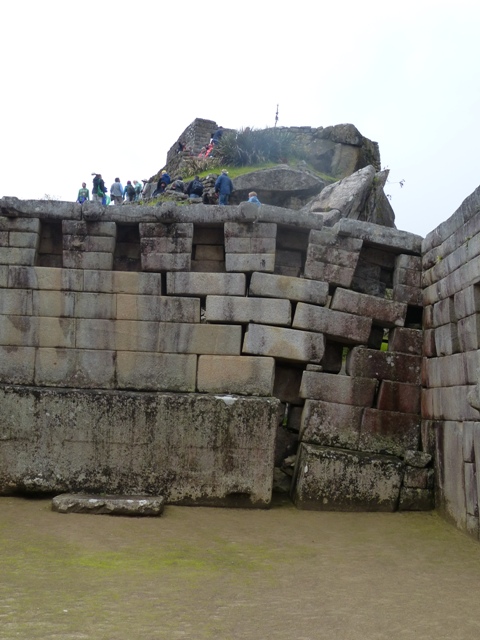 I told you above that we caught a bus up. We could have walked up the “Camino”…..
I told you above that we caught a bus up. We could have walked up the “Camino”…..
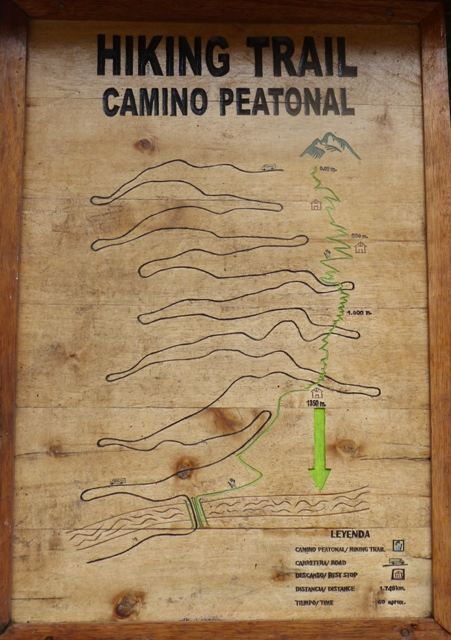 …….which winds its way up the hillside crossing the road several times. We were advised by some friends who visited just before us that if we wanted to walk the footpath then down was the better option. Great advice Stephen and Sandra – forever in your debt! The height gained/lost during the walk is 1,400m [nearly 4,340ft] and Aguas Calientes is already at 2,410m [7,470ft] so the altitude, whilst not the greatest we encountered, does have an effect. Not to mention what climbing more than 3,000 steps would have been like! Coming down was a much better option and a nice way to finish our visit.
…….which winds its way up the hillside crossing the road several times. We were advised by some friends who visited just before us that if we wanted to walk the footpath then down was the better option. Great advice Stephen and Sandra – forever in your debt! The height gained/lost during the walk is 1,400m [nearly 4,340ft] and Aguas Calientes is already at 2,410m [7,470ft] so the altitude, whilst not the greatest we encountered, does have an effect. Not to mention what climbing more than 3,000 steps would have been like! Coming down was a much better option and a nice way to finish our visit.
Machu Picchu is not included in the general Boleta I spoke of. You have to have a separate day pass [or longer if you wish]. You book these in advance on the Peruvian “Minesterio de Cultura” website. The cost varies depending on how long you want to be there [i.e. longer to walk the Inca Trail] and what you want to see/do [e.g. The Museum and the Wayna Picchu trail cost extra and must be booked and paid for at the time of purchasing the Machu Picchu ticket.] The Lonely Planet did not say that the Cerro Machu Picchu walk had to be booked in advance but when we enquired we were told we couldn’t pay on the day. Probably a good job in actual fact due to the weather and the number of steps you have to climb anyway among the ruins.
The Inca Train option we booked [there are two types of train and the time of day also affects the price] cost $120[£80]pp return. There is no other way of getting there and, booking this in advance is also essential. We were not there during high season and the train was full. The Machu Picchu ticket was $43[£31]pp. So, it’s not the cheapest thing we have ever done but considering Machu Picchu is the most famous Inca site and probably one of the foremost archaeological sites in the world it could have been worse!
On the way back from Ollantaytambo to Cusco we managed to catch a “tourist taxi” which had dropped some people off and was returning. We had the minibus to ourselves and knew the price of a seat on a full “collectivo” so basically offered the driver the same money. Not sure he was too pleased but he had the choice of at least making a little money so took it. Crossing the Altiplano we had lovely views of the mountains we hadn’t been able to see from Machu Picchu the day before – though looking back to Machu Picchu it was again covered by cloud so was probably still raining there.
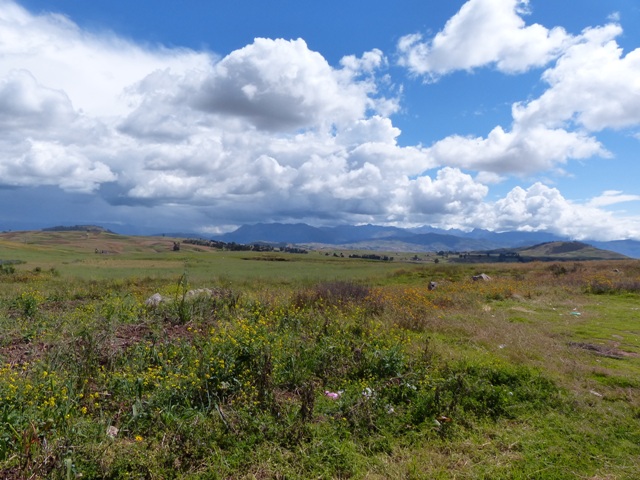 The Boleta did, however, include Tambomachay, Q’engo, Pukapukara and Saqsayhuamán – all of which we covered in a brilliant 8km walk on our last day in Cusco. By catching the same bus as we had ridden to Pisac and getting off about one third of the way there [at Tambomachay – altitude 3700m (11,470ft)] we were able to walk down the valley and back to Cusco.
The Boleta did, however, include Tambomachay, Q’engo, Pukapukara and Saqsayhuamán – all of which we covered in a brilliant 8km walk on our last day in Cusco. By catching the same bus as we had ridden to Pisac and getting off about one third of the way there [at Tambomachay – altitude 3700m (11,470ft)] we were able to walk down the valley and back to Cusco.
Built around AD1500, using local limestone, Tambomachay means “Resort” and is where many Incan’s lodged as it was on a junction along the “Kapak Ñan [Great Road]. It is also known as “The Baths of the Princess” has two aqueducts which provide spring water all year round.
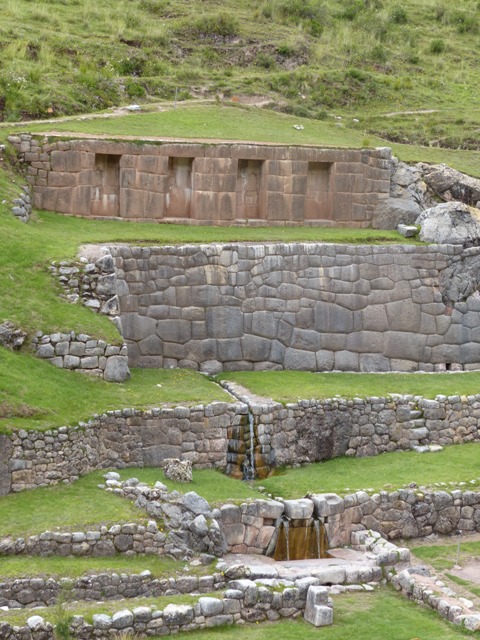 Most spectacular were the views of the mountain backdrop….
Most spectacular were the views of the mountain backdrop….
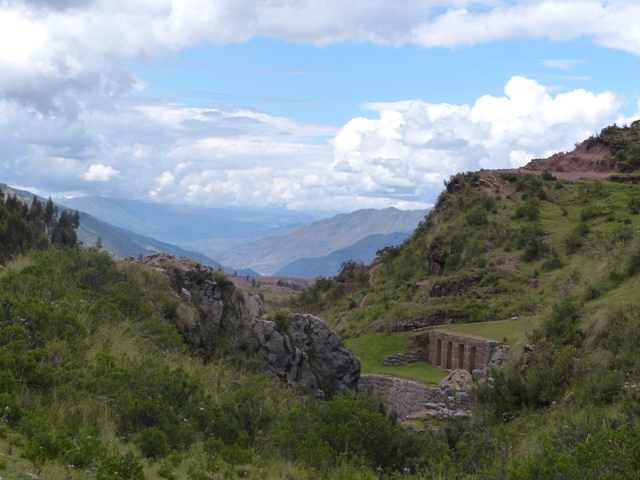 Approx 1km down the valley Puka Pukara….
Approx 1km down the valley Puka Pukara….
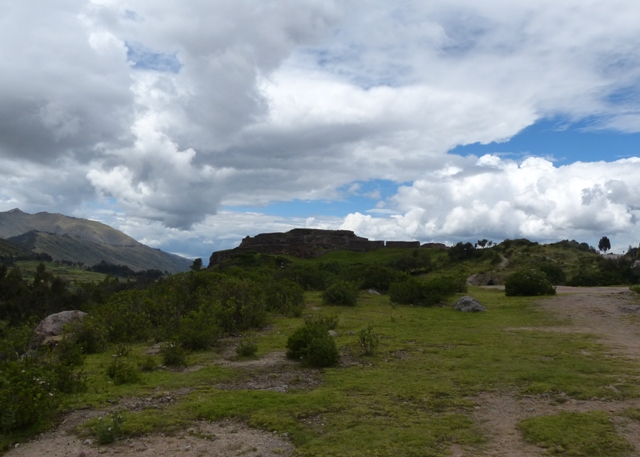 ….used to be a road control and administrative centre mainly occupied by the military. It was built on a buttress and surrounded by a wall and containment terraces.
….used to be a road control and administrative centre mainly occupied by the military. It was built on a buttress and surrounded by a wall and containment terraces.
We then walked inland and down the valley passing a “modern” village….
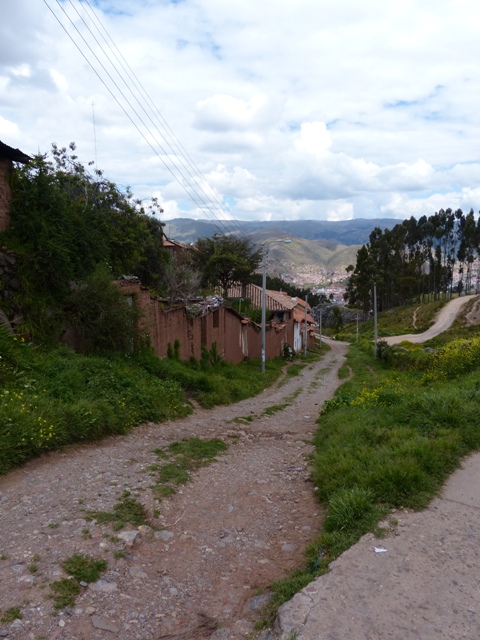 ….with a small “tienda” [shop] where Mike bought beer which we both enjoyed!
….with a small “tienda” [shop] where Mike bought beer which we both enjoyed!
Just round the corner was Q’enco – meaning labyrinth. It was a sacred sanctuary for the worship of fertility and much of it was destroyed by the Spaniards in their attempt to do away with idolatry.
It did not take us long to walk round the few remaining walls.
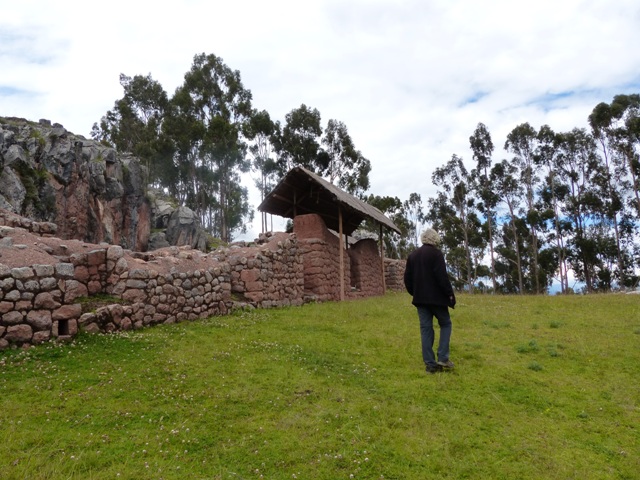 Not so Saqsayhuamán which is an immense ruin of military and religious significance. Sometimes spelt Sacsaywaman it is easy to remember because its pronunciation sounds like “Sexy Woman”!
Not so Saqsayhuamán which is an immense ruin of military and religious significance. Sometimes spelt Sacsaywaman it is easy to remember because its pronunciation sounds like “Sexy Woman”!
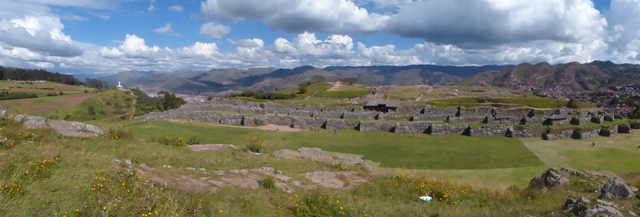 There are three tiers of defence walls built, with amazing precision, of stones which fit in a zigzag pattern to represent the teeth of the puma. Some of these are huge….
There are three tiers of defence walls built, with amazing precision, of stones which fit in a zigzag pattern to represent the teeth of the puma. Some of these are huge….
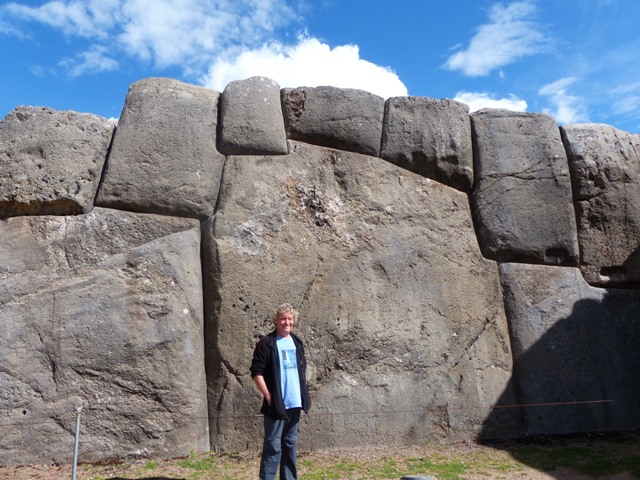 ….how they got them there and stood them up I’m not sure! Many are upwards of 70tons and the largest stone on the site reputedly weighs about 300tons.
….how they got them there and stood them up I’m not sure! Many are upwards of 70tons and the largest stone on the site reputedly weighs about 300tons.
Apparently what we see today is only about 20% of the original fortress. Much of the stone was taken by the Spaniards to build Cusco.
In 1536 the site was one of the bitterest and bloodiest battles between the Incas and the Conquistadores. Due to the Spanish initially only lightly guarding the hill fort it was recaptured by the Incan chief Manco two years after the first conquest. Manco Inca then used it to lay siege to the Conquistadors in Cusco and almost succeeded in overcoming them. However an additional Cavalry force was used to attack him killing thousands – most of Manco’s force. He retreated first to to Ollantaytambo and later, after being besieged once again, to Vilcabamba – his jungle stronghold and the last Incan refuge which fell in 1573. The Spanish included eight condors in their Coat of Arms for Cusco as a result of the number of scavengers which came to eat the Inca warriors bodies.
Having enjoyed Geology at school I was particularly interested in the rock strata around the site….
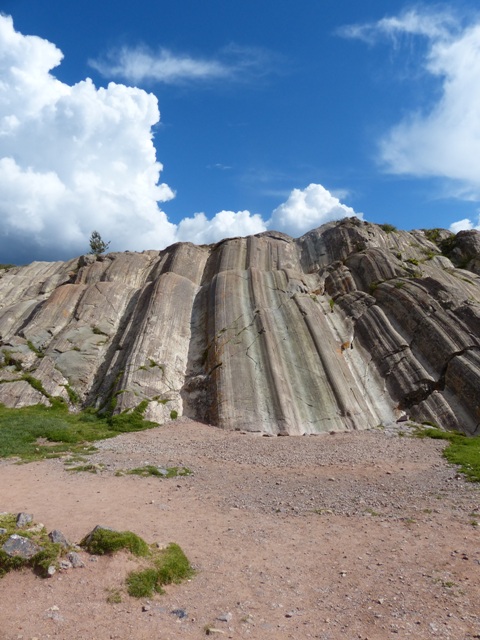 …. the small limestone caves and passages…..
…. the small limestone caves and passages…..
….and the natural chair which provided a well earned rest!
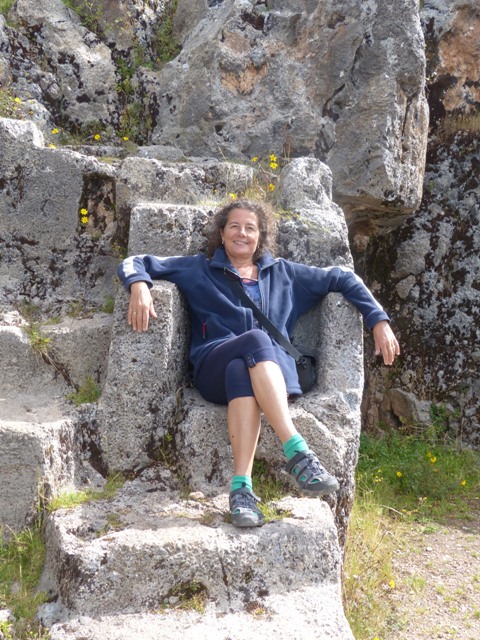 Before taking the cobblestone route down, into San Blas and then into central Cusco, we saw the Saqsayhuamán Plaza which overlooks the city and from which, no doubt, Manco plotted his attacks.
Before taking the cobblestone route down, into San Blas and then into central Cusco, we saw the Saqsayhuamán Plaza which overlooks the city and from which, no doubt, Manco plotted his attacks.
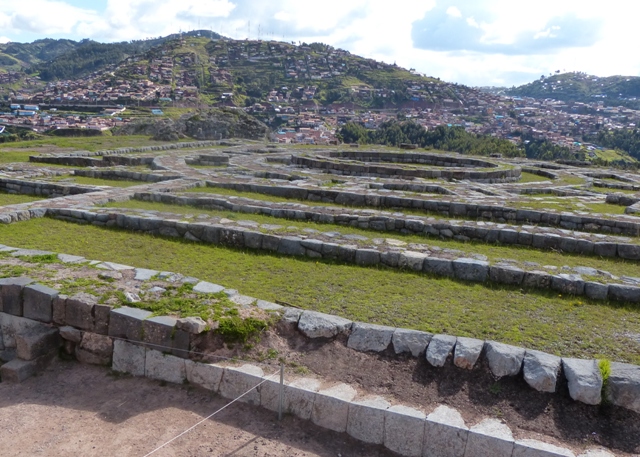 Of course it was now time for another beer and, in Cusco there is actually plenty to chose from and lots of watering holes to drink them in. These Irish get everywhere….
Of course it was now time for another beer and, in Cusco there is actually plenty to chose from and lots of watering holes to drink them in. These Irish get everywhere….
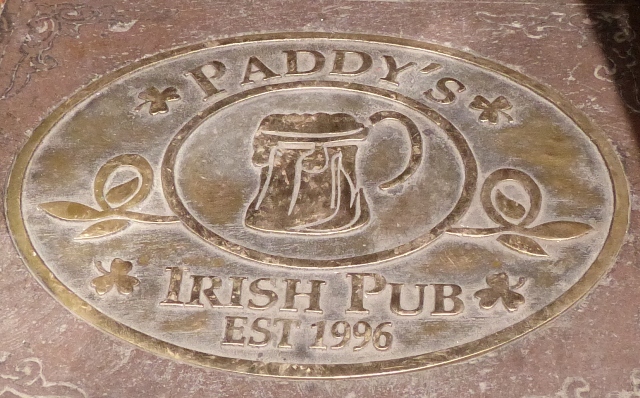 ….though rather than the good old black stuff it was a different sacred brew….
….though rather than the good old black stuff it was a different sacred brew….
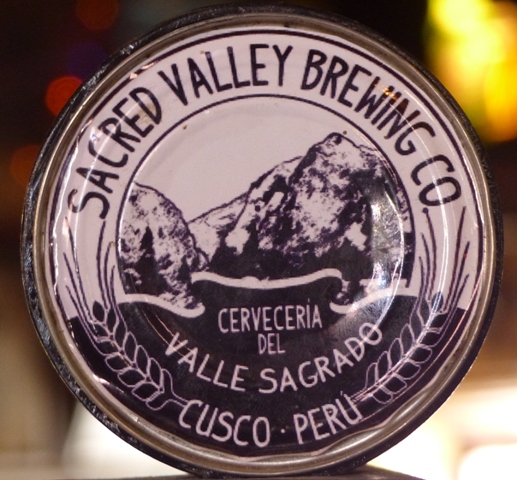 Now, you were probably thinking that that was the last photograph because my posts often seem to end with alcohol of some description. But, how could I? This has been all about the Sacred Valley and the Incas and it would not be fitting to end with anything other than this…..
Now, you were probably thinking that that was the last photograph because my posts often seem to end with alcohol of some description. But, how could I? This has been all about the Sacred Valley and the Incas and it would not be fitting to end with anything other than this…..